




























WWe’re swamped these days with bass fishing facts, figures, details, knowledge and intelligence. It used to be that we had to wait until a tournament was over before the winning angler spilled the beans about the secrets of their success. Even then critical details were conveniently forgotten or concealed. Not anymore. Now we watch the events live on our cell phones as we’re eating dinner in a restaurant two thousand miles away. We can even zoom in, freeze the on-screen action and spy the lures tied to the ends of the rods in the corner of the bass pro’s boat. In a matter of a few short years, we’ve have gone from a dearth of details to a tsunami of bass fishing facts. And it has produced some strange habits and behaviours.
How many bass anglers, for example, watched Canadian Bassmaster Elite pro, Jeff “Gussy” Gustafson hang a fluke-style bait over the side of the boat at the 2021 Bassmaster Elite event on the Tennessee River and shock his fellow competitors by catching bass using his “moping technique”?

rushed out and bought the bait, hung it over the side of the boat and… moped up nothing. We’ll let Gussy explain why in a moment.
A few weeks later, Japanese pro, Takumi Ito, stunned the same Bassmaster Elite field on the St. Lawrence River, sacking a five fish 26-pound limit of smallmouth bass on the final day of the tournament using a 4-inch Ecogear Aqua Swim Shrimp. I am guessing that so many bass angler bought the bait afterwards that they’re still hard to find these many months later.
The new reality is so many of us are focused on tournament results that presentation options are becoming a blur. As a consequence, we’ve forgotten how to put together a basic game plan for the lake we’re fishing and then switch things up when that plan doesn’t work out. Worse still, we often won’t listen to what the fish are trying to tell us, force feeding them instead with the latest winning bait.
Also lost in the mix is the reality that while 26-pound bags of smallmouth bass are achievable at the eastern end of Lake Ontario and the St. Lawrence River, they’re not possible in the vast majority of the lakes, rivers, reservoirs, pits and ponds that most of us fish on a day-to-day basis.

“I almost always start fishing in a way that’s fun for me,” says Canadian Open champion, Derek Strub, one of the winningest anglers on the Great Lakes these days and a master tactician renown for his drop-shotting skills. “I focus on three presentations. A chatterbait, spinnerbait and topwater lure. I fish through areas quickly, try to catch the most aggressive bass and keep on moving.”

Strub’s game plan sounds simple, but when you look at his starting lineup of lures –none of which, ironically, includes his

cherished drop shot rig – it’s the same strategy employed by every good bass angler. With two or three different lure styles, you can efficiently and effectively comb the water column, from top to bottom, at every speed imaginable. It is the gospel that Just Fishing has been preaching for years.
Every time you tie a lure to the end of your line, you need to factor in depth control and speed control. So, if you‘re alone with three or four rods in the boat, rig one with a tube jig, Ned rig, grub or swimbait that you can fish along the bottom at various speeds. You need a second combination to prospect the middle of the water column and a third for up top on the surface. Two or more anglers in the boat, simply speeds up the elimination, fine tuning and zeroing in process. So, one high, one low, one fast, one slow.
Simple shines!

Which brings us to Mr. Gustafson and the “moping” technique that he used so successfully on the Tennessee River. It is a (Continued on page 4.)


I have to admit, if you’re a Canadian bass fishing enthusiast the month of April 2023 is one that won’t be forgotten for some time to come. It will surely never be forgotten by myself and Jeff “Gussy” Gustafson, aka the “Great Canadian Snow Leopard”!!!
On the Thursday evening leading up to the Bassmaster Classic in Knoxville Tennessee, I had the honour of being the the first Canadian inducted into the Bass Fishing Hall of Fame in Springfield Missouri. I was presented with the Meritorious Service Award and became only the third individual to receive this award... a total honour!!!
Little did Jeff and I know while sitting at the event chatting, that in just over 72 hours he would claim the title of Bassmaster Classic World Champion! Plus In doing so, he became the first Canadian to ever bring that title home to Canada. You can find more on both these events later on in this issue beginning on page thirty (30).
The Spring issue features our incredible line up of writers and anglers, sharing vital information and experiences to hopefully make you a more informed and successful angler this year and into the future.
I recently had a wondrous conversation with the “Ice Boss” himself, Dave Genz, who had called to congratulate me on my Hall of Fame Induction. Dave mentioned something during that conversation that really got me thinking. It was how he had spent most of his life teaching people how to catch more fish. But he finds himself now trying to teach those same anglers to let most of thier fish go... Ringing so true... It literally stopped me in my tracks.
Preservation of our fishery is very important – so when you’re out fishing this year, be sure to keep that in mind… it really is all about the future!!!

Be safe & when ever possible, take a kid fishing!!!
Unsolicited articles are accepted and will be considered for publication provided they are original and have not appeared in other publications. Publisher
“Big” Jim McLaughlin
Managing Editor
Tammy Wight
Contributors
Gord Pyzer
Al Lindner
Tim Allard
Jeff Gustafson

Bernie Schultz
David Chong
Cameron Tait, Brian Brosdhal
Jeff Matity
Box 214 Seeley’s Bay, ON K0H 2N0.
Phone: (613) 387-8735
Email: info@justfishing.ca
www.justfishing.ca
All Rights Reserved Reprinting or reproduction in whole or in part is forbidden, except by written permission of the publisher.
On The Cover: Main – Bassmaster Classic Champion Jeff Gustafson, photo – Cody Rubner, The Best Jumbo Perch Fishing photo – David Chong, When Keeping it Simple Shines photo – Derek Strub, Current on River Walleyes photo – Brian Brosdhal, In the News photo – “Big” Jim
lesson in understanding that lures are simply tools you use at the right time, in the right location, in the right way.
“I learned very early on that fluke-style baits are a top choice for smallmouth bass when they are focused on eating baitfish in cold water,” says Gustafson. “The big thing that we learned from the Lindner’s, back in the early 2000s, when they were winning the Fort Frances Canadian Bass Championship on Rainy Lake is that they were catching smallmouth on and around structure, but they weren’t letting their baits touch the bottom. That is the most important aspect of the technique. Around the same time, electronics were getting better so we could find fish and then watch how they reacted to our baits.



“The “hanging”, “moping”, “Damiki rigging” technique became widely used to win a lot of tournaments in Northwestern Ontario, especially when we found smallmouth in deeper water from August all the way through the fall. Over the years I have caught hundreds of bass doing it. But like any technique, the more you do it, the more efficient you become understanding the mood of the fish, choosing the right jig head and knowing when to put it away and try something else.”
(Continued on page 6.)

The ever personable Gustafson smiles, as though adding an exclamation mark to that last point, because it highlights a critical detail that many anglers ignore when the tournament winning technique bug starts blurring their vision. As Kenny Rogers reminded us in the Gambler... You’ve got to know when to hold ‘em, know when to fold ‘em, know when to walk away, know when to run.
“When I started fishing the FLW Tour,” Gustafson explains, “I had the fluke/jig tied on at many events where I thought I could fish deeper water, but I just never hit with it anywhere. I really thought it would work great for spotted bass because their nature is so similar to our smallmouth. They use their eyes a lot, they like to suspend and they’re fairly aggressive. But I learned that spots don’t like the bait hanging above them, which is what drives smallmouth nuts. I’d watch the spots race up to my fluke and then put on the brakes and never bite it. So... I put the technique in the rod locker for a few years.

“At the Tennessee River event last year, I have to be honest, I didn’t go there thinking that I’d catch my fish the way that I did. In fact, I didn’t even tie the bait on until midway through the final day of practice. I had fished through the area and had caught a couple of small smallmouth on a Ned rig and blade bait. I am not even sure
what made me do it, but I quickly rigged a 4-inch Z-Man Jerk ShadZ on a 3/8-ounce Smeltinator jig, dropped it down, stopped it a few feet above the bottom and within ten seconds a smallmouth swam up and smoked it. I repeated it a few more times and knew that I was on to something.

“I came back the next morning, on the first day of the tournament, and the fishing was even better and easier than I could have imagined. My technique was the best way to catch them. I knew that I didn’t have to try another bait because there were other good anglers fishing around me and they weren’t catching them. The funny part was that I only had six or eight of those jig heads in my boat because I didn’t go there expecting to fish that way. After the second day I was digging through my roommate’s tackle for a few more jigs to get me through the tournament.”
What Gustafson’s win highlights, of course, is the importance of listening to the fish. Pay attention and most days they’ll tell you what you need to know. Several years ago, for example, I was filming an In-Fisherman television segment on Rainy Lake with editor-in-chief, Doug Stange. It was early spring, the water was calm, clear and cold. We were enjoying mediocre success casting Rapala
(Continued on page 8.)

X-Raps until after one cast, I ripped the lure down, paused for a second or two, ripped it down again and then laid my rod against the gunnel of the boat while I poured a cup of coffee. My rod almost flew out of the boat when a four-pound plus smallmouth ate the bait sitting dead still in the middle of the water column. Now, I may have been born at night, but it wasn’t last night, so I quickly cast out the jerkbait again, ripped it down and then let it pause interminably. Another smallmouth destroyed it. Then another, and another, and another until Doug shook his head in mock disgust – or maybe it was real – and made note of the Painfully Protracted Pregnant Pyzer Pause. But that one simple change, facilitated by listening to the bass, turned an otherwise ho-hum day of fishing into a stellar success story.
Simple shines!
Of course, monitoring the success of your favourite tournament angler is fun, but emulating a winning presentation can be frustrating, because there is always more to it than first meets the eye. As Gustafson has already told us, he spent 20 years perfecting the moping technique and tried it repeatedly – and unsuccessfully – at different events and couldn’t make it produce... until he did.
“That is how you should spend your fun fishing days,” says Strub, who has over 200 top ten tournament finishes to his credit. “But remember, anything new these days


isn’t as easy as grabbing whatever rod, reel, line and lure combination you need and having at it. Spy baiting is a perfect example. Every serious bass angler knows about it by now, but to spy bait well, and more importantly, ensure a decent to excellent landing ratio, you have to spend the time required to dial things in. So use your fun fishing days to experiment with different rod actions and line pairings to achieve greater success.”

(Continued on page 8.)


Another overlooked reality is that many tournament winning tricks, tactics and techniques simply don’t play well to your geographic area, or your style of fishing. If you’re a run-and-gun A-type bass angler, for example, you’re guaranteed to have issues trying to fish an ultra-slow finesse method. Especially, if that tactic is best suited to deep clear western waters and you are fishing shallow stained eastern lakes. And vice versa.

I was never more impressed with this notion of fishing to your strength than when the late Guido Hibdon and his son Dion – the only father and son to have each won the Bassmaster Classic – fished the Kenora Bass International on Lake of the Woods. They had never seen the massive one million acre body of water before the competition, yet they quickly put together a second place finishing game plan, beating all but one of the other 125 teams.
When I quizzed Guido after the three-day contest about how he was able to break down such an intimidating body of water so quickly, he chuckled and said, “Actually it was pretty easy. Before the tournament began, we learned from several of the teams that they had done well in previous years fishing with crankbaits. That is not our strength, but it told me that the smallmouth were relating to rocky bottoms and feeding on crayfish. When I learned that, I knew we could catch them on tube jigs. That is our favourite way to catch smallmouth. In fact, on Dion’s very first cast in practise with a tube, he hooked a near four pound fish. From that point on I knew we were snake bitten.”
Simple shines!
What Gustafson, Strub and the Hibdons have also demonstrated, of course, is the wisdom and benefit of mastering a select few stellar techniques, as opposed to chasing after every winning presentation and becoming a jack of all trades.
About the Author – Gord Pyzer:



“The truth is that unless you are an Elite or MLF touring angler that travels coast-to-coast and east-to-west, you really don’t have to be an artist with every technique,” says Strub. “The best bass anglers in North America are known to be one or two bait-presentation experts. Arguably, even the great KVD will be known as the best cranking angler of all time.

“Master a few techniques in the lakes and rivers that you like to fish and you’ll have a much better chance of being consistently successful. The less experienced anglers who are always chasing the latest fad or the technique that won the event on the weekend rarely settle into a rhythm. They don’t search for fish in the areas that suit their skills and so, they rarely fish confidently. I’ve competed in hundreds of tournaments and I always try to find fish in areas and at depths that let me fish the way I know I am good at. It doesn’t always work out, but if I can find those fish, I will always finish better in a tournament.”
Simple shines!
2009 Inductee, Canadian, Angler Hall of Fame, Fishing Editor, Outdoor Canada Magazine, Field Editor, In-Fisherman Magazine & Television, Co-Host, In-Fisherman Ice Fishing Guide, Television, Co-Host, The Real Fishing Radio Show, Host, Fish Talk with “The Doc”, Outdoor Journal Radio & President, Canadian Angling Adventures Ltd.



AAs crappies finish spawning, the larger females begin leaving nesting sites, while the males remain to protect eggs and fry during the incubation and hatching process. Females begin filtering out across the adjacent flats, toward but not yet into the deeper water of the basin. Developing weed flats outside the mouths of spawning bays, or adjacent to stands of main-lake reedbeds, become focal points of post-spawn and presummer activity.
Weeds are not yet fully developed at this time, so crappies are on the move, at least initially. They begin filtering out toward the adjacent drop-off, searching for clumps of developing weeds that provide both cover and feeding opportunities atop the edges of shoreline flats meeting the basin.
In many cases, you can see these weed clumps in clear-water lakes, especially with the use of polarized sunglasses. If the water is stained or dark, they may be difficult or near impossible to see with the naked eye. Casting and retrieving lures that tickle or occasionally snag the taller weeds provides a clue to their location. Even better, using Humminbird Side Imaging while slowly cruising atop these flats provides clear images of weed clump location, thickness and height, and often reveals the presence of fish themselves.

We like to say that the larger females are the first ones in, and then the first ones out, of spawning areas in spring. That means some of the largest fish are the first ones to arrive at the outer edges of the weed flats. Reluctant to drop down at first into deeper, colder water,
known areas with a bobber rig once the fish are located may catch more crappies if the fish are spooky or less active. Experiment with both approaches to see what works best.


provide lifelike minnow profiles. The marabou tail exhibits a breathing action, even at rest.
back to the boat at different depths until we either begin catching fish or are ticking the tops of weeds without snagging. Either way, we should be in the strike zone just above the fish’s heads. Crappies like to “feed up,” meaning rise to strike lures or baits moving slightly above their heads.
We usually begin by slowly drifting or using our trolling motor to move along the depth range at which weed clumps are beginning to develop. Let’s say it’s around 6 to 7 feet. We’ll keep the boat in about 8 to 9 feet of water and cast up shallower, working our lures through the key 6- to 7-foot zone.
We cast out and let our jig sink, counting, “One thousand, two thousand,” etc.
Our lure of choice is a 3/32-ounce Big Bites Lindner Baits Lindner’s Panfish Special jig with a rounded, soft-plastic body and marabou tail. It has the line tie on top of the jighead to be able to either vertically jig or fish it below a bobber. They come in different colours. Experiment to see what the fish prefer. (Continued on page 14.)






(Opening Day Walleye continued from page 2.)

Once the jig descends to the desired depth, hold your rod tip up at about the 10 o’clock position and slowly swim the lure back to the boat, occasionally ticking weed tops. Strikes can range from solid thumps from active fish, to barely getting heavy from less active ones. When you get on a hot area, use the Spot-Lock feature on your Minn Kota trolling motor to hover in place, making repeated casts to the key spot.
If the fish slow down, or aren’t particularly active, switch to a bobber presentation that vertically suspends the jig below your float at the same depth you caught fish previously. Cast slightly upwind and let the wind and waves slowly drift the jig, with the waves imparting a lifelike action to the jig. If there’s no wind, cast past the spot, slowly bring it back with a few slow pulls, jiggles and pauses to make the lure appear alive.

When you hook and land a fish, your knot tends to slide on the hook eye; if you don’t reposition the knot, your jig will hang tail-down below your bobber, appearing lifeless. Instead, grip the jig in one hand and the line in the other, and pull to make the knot slide more toward the front of the hook eye. Done properly, your jig will now hang horizontally below your bobber, imitating a live minnow.
We like to use light line and tackle to effectively cast and fish these tiny lures. 4-pound test Sufix NanoBraid braided line, or Advance monofilament line, makes it easy to cast tiny lures longer distances, and the jigs tend to perform better with light, flexible line. With braid, add a short fluorocarbon leader between the jig and your main line for invisibility, to provide a little cushion on the hookset and avoid breaking the light line, and to help deflect the razor teeth of bait-stealing northern pike.
We fish these baits on St. Croix Avid or Elite Panfish rods, in 6’ 4” to 7’ 0” lengths and light or medium-light action, for a good balance of castability, cushion to absorb strikes and sufficient strength to fish large panfish on light line. Teamed with a series 1000 Daiwa spinning reel, you’re rigged and ready to tackle panfish all season long.
This pattern lasts about a month, with the fish moving farther out toward the drop-off as the weeds thicken. By summer peak conditions, when the weeds are at their peak of thickness and height, the crappies tend to school tighter and hide beneath the weeds during the day, coming out to the edges or rising over the tops to feed in early morning, late evening or at night.
Sometimes crappies hit everything you throw at them; other times, you need to fine-tune your approach, lure size, colour, speed, action, depth, etc., to make the magic happen. In recent years, there has been an absolute crappie explosion in southern Canadian Shield lakes just above the U. S. border. The stained water really grows lots of big fish. If you understand their seasonal movement, and how they relate to developing habitat and forage sources, you can stay on crappies all year long.
About the Author:
Al Lindner ranks among the most renowned leaders in the fishing industry. Averaging about 180 days a year on the water, Al is hailed as one of the world’s best all-around anglers. Al’s long and honoured career as an author, syndicated radio & TV fishing show host, video producer, fishing guide, tackle manufacturer, lecturer and champion tournament angler has spanned 35 years of the most revolutionary years in sportfishing.
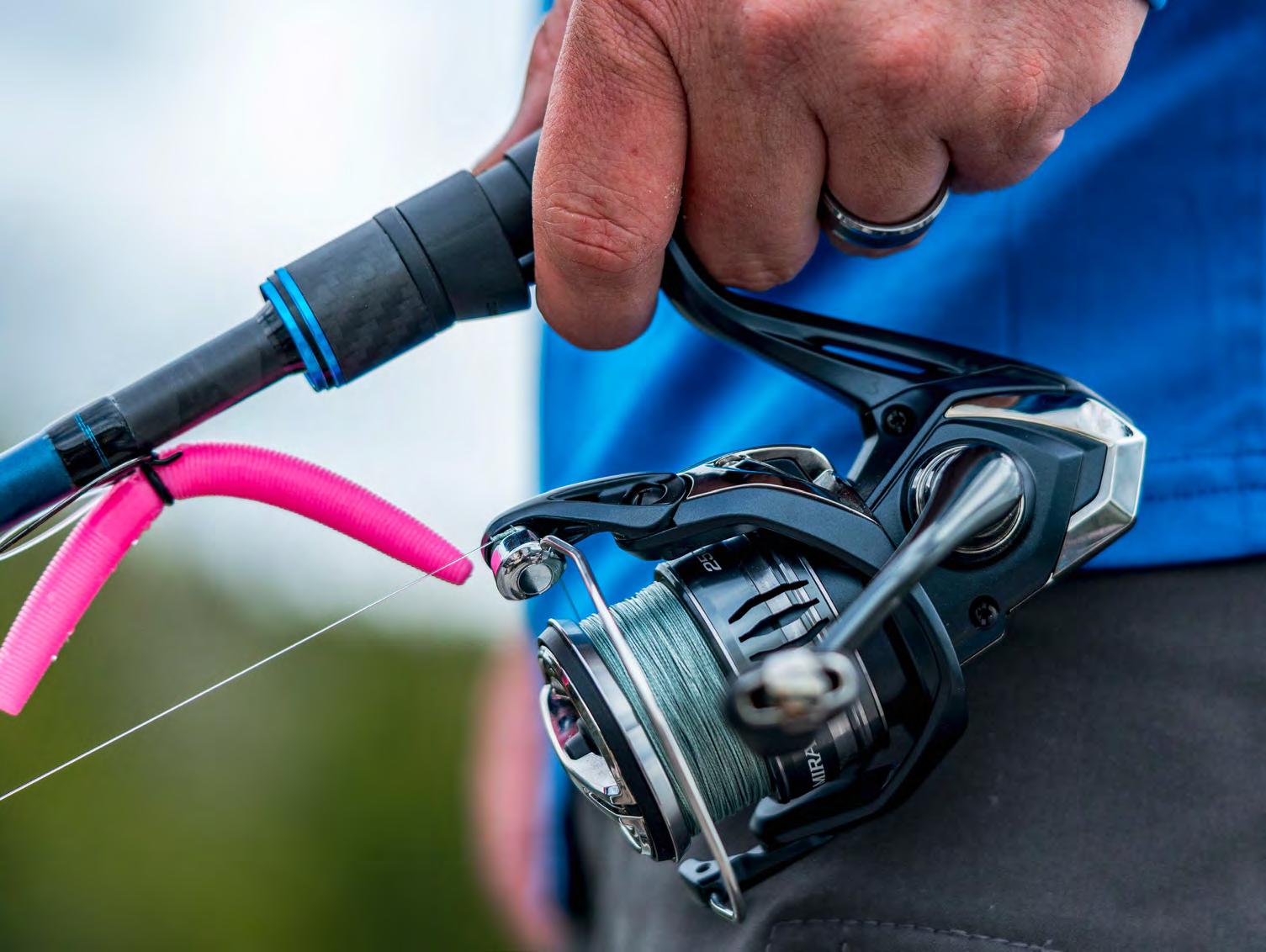




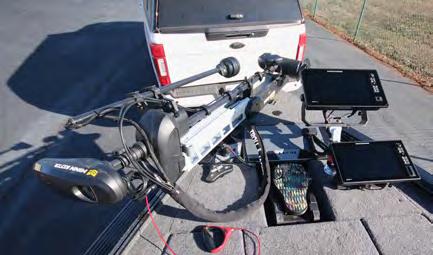
M M




onths ago, when ice started to form on our lakes and winter was setting in, it was hard to believe that we would actually get to be in a boat again. I love



It’s showtime. New MEGA Live Imaging™ delivers the edge-to-edge clarity you need to see exactly what’s below the surface in real time, with no gaps in coverage and MEGA Imaging® detail across the entire view. Want to know if a certain area is worth fishing? You can be absolutely certain with crystal-clear, live sonar returns of fish, structure and your lure, in Down, Forward or Landscape Mode. There’s no image like it. For real. Learn more at Humminbird.com/MEGALive


console and two at the bow. I went with two Humminbird Apex and two Solix machines this year. At the console, a Solix is dedicated to mapping, while an Apex is used for sonar – traditional 2D, Side-Imaging and Down-Imaging. At the front, an Apex unit is dedicated to Mega-Live, while a Solix is dedicated to mapping, sonar and Mega 360. They are all linked together via ethernet and have the ability to share all sonar, mapping and waypoints together.
The Mega-Live forward facing sonar is the most important electronics item on my boat. This is my third year using this technology and this is by far the best it has looked. A combination of some updates that Humminbird has had for Mega-Live and the clean power that it’s getting from the rigging job is allowing me to see my bait 90 feet out in front of the boat. If there are fish around my boat, I’m going to see them, it’s incredible.
If you have not jumped on the forward facing sonar wagon yet, you should consider it if you can swing it. It is a lot of fun to use and it will without a doubt help you catch more fish on every outing. Almost every day on the water I catch a fish and I’ll say to myself, “without Mega-Live, there is no way I catch that fish”. I might see a single fish or a school out behind the boat, maybe a fish suspended or I see a piece of cover like a rock, grass clump or log that I would have never known was there. I can pitch my bait to it and often a fish will reveal itself and bite. It really is incredible.
the easiest fish there is to clean out of a lake. This technology makes finding and catching them very easy so anglers need to be careful not to hammer on them as hard as they can. Keeping a few fish to eat is great, I love eating fresh fish at shore lunch or for dinner but we have to be careful not to damage our fisheries or we’ll continue to lose more fishing opportunities.
Heading into a new season there are always some new trends in tackle. While I can’t say there is some magic, never-before-seen lure hitting the market this year, one trend is using baits that function well with forward facing sonar.




For me, two different soft plastic baits are tied to my rods all season long, everywhere I fish for walleye and bass. These baits catch most other species as well. A jerk shad style minnow bait, rigged on a jig head has been a popular bait for over a decade in central Canada but it is a phenomenal bait to use in conjunction with forward facing sonar.
Obviously, there is some responsibility on all anglers to not exploit our fisheries with this technology. Crappies, which group up in large schools through the fall and winter are
When I see fish on my electronics out in front of the boat, swimming this bait a couple of feet above the fish is an awesome way to catch them, especially if the said fish are focused on eating pelagic baitfish like smelt or cisco, which are present in many of our waters. My bait of choice is a Z-Man Scented Jerk ShadZ rigged on a jig head like a Northland Mimic Minnow or Smeltinator head.

(Rigged & Ready for Spring continued from page 18.)
“If you’re fishing summer spots and they aren’t there, start fishing the sand. As the transition is getting underway, it’s still common to find walleyes
How you set the hook depends on its size, diameter and thickness and when it is small, thin and razor sharp, a smart sweep of the rod tip is all that is required to nab every fish.
(What’s Hot On Ice continued from page 37.)
spawning shoal, itself, these guardian fish fast for weeks and weeks, never leaving the eggs,” explained Paragamian.
The second bait for me is a Ned rig, which I can use to pitch to specific targets like a boulder, a log or fish that are located closer to the bottom. I almost always use a green pumpkin Z-Man Hula StickZ, rigged on a Northland Elite Series Ned jig, which features a Gamakatsu hook. I catch more fish on those two baits than anything else
“So, non-spawning guardian fish stay on the shoal, defend territory, and fast to the point of near starvation. Why?” I wondered out loud.


FLX-30 BB flasher/ fish finder featuring – 7 frequencies from 160 to 300 kHz, 140 interference rejection options, target ID down to 1/4”, Digital depth displat, Day & Night display settings, Battery status & low-battery alert, 3 power level settings & zoom zones. Plus Vexiar’s exc;usive broad band Ice-Ducer transducer & float, 12 volt, 9 amp-hour, Vexilar Lithium battery, fully automatic charger, Soft Pack carry case, adjustable rod holder, external power posts for accessories and a custom Vexilar tackle box.
I received a message from a reader last fall about catching big smallmouth, largemouth and northern pike. He had been unsuccessful in his efforts and asked if I’d help him zero in on the key depth. I flipped him back a note asking what species, in particular, he was targeting. He

“Walleyes begin to move deeper as water temps drop toward turnover . Instead of looking for fish to be on top of

“Well, why do most organisms on earth do outrageous things in the name of procreation?” retorted Paragamian. “One word: hormones. It’s primarily light and temperature, as well as other environmental cues that begin the cascade of hormones causing this behavior. There must be a mechanism by which they ‘know’ it is time to leave before their bodies give out completely. Bottom line, as long as the fat reserves in their liver hold up, they can stay.”
Now, there is no question that when you are fishing for walleye, as a case in point, that you may catch a bonus smallmouth, largemouth or northern pike. Maybe even several. But is it a huge mistake to assume it will happen and thus, go fishing without a specific species in
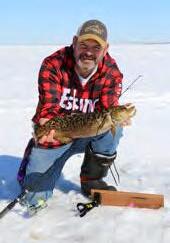


“They will be in spots like the sharper breaks or on mid-lake humps that top out at perhaps 20’, rather than 15’, or in holes in soft-bottom flats where depth drops from 15’ to 20’.
and a 10-lb. fluorocarbon leader, attached by an FG knot. I like the yellow braid because it’s easy to see, so I can watch it. I’ll notice bites and when my jig hits the bottom.
I use to accompany the Conservation Officers and fisheries technicians who worked for me and we would pull alongside anglers and do a creel survey. I was always amazed when the folks in the boats were asked what they were fishing for and they replied ....
Glo-Shot Spoons are a killer on crappies, perch, walleyes, pike and trout. Cast or vertically jig... the S-curve design and light, lead-free construction excels with twitches, lifts and falls. in low-visibility situations. Change Glo-Shot Tip with live bait or IMPULSE plastics. Glo-Shot 1/16-, 1/8- and 1/4-ounce weights, with red treble hooks in #12, #10 and #8 sizes, respectively. Hooks are rings for added action and fewer lost fish. Sticks are non-toxic, easy to activate and glow in vivid colour for eight hours. They are light enough not to affect lure action and are also great for lighting up a variety of bobbers, hooks and jigs.


Finally, knowing the purpose of non-breeders’ presence - territorial egg guarding – explains why, as individuals or as a mob, they shun every living creature that dares invade their claim. Ciscoes are their primary antagonist, the target of the non-breeders’ disdain and fury.
“Walleyes become more selective about where they stage. They generally locate on a spot-on-a-spot. For example, if they’re on a mid-lake hump with scattered boulders, they will be on the boulders. If all rock, look for the patch of sand. If all sand, look for the rockpile.
To be successful, you have to focus in on a specific species, learn as much as possible about its lifestyle, habits, behaviour and seasonal preferences. Then you need to use the information to select prime locations, the best lures and optimal presentations. To do otherwise is to take a shot in the dark, which almost always misses the mark. Leave the hail Mary passes to the last minute desperation plays for

Do the work now guys and get ready for the new season so when it starts you can spend as much time as possible out on the water. I hope everybody has a great season!



from Northland brings the noise with a glass rattle and audible carry through water, all without killing its
“Because more and more walleyes show up on these few spots, more and more of the lake holds no fish. It’s easy to be skunked if you don’t pay attention to subtle differences on the structure.”
Stakeouts with my AQUA-VU revealed ciscoes making forays to the bottom to gobble up eggs and then retreat, vertically, to just below the ice. When so incensed, frenzied ciscoes will attack lake trout- sized jigs. On a united front basis, the burbot chase allcomers away from the bottom. But, because they won’t leave their eggs, they won’t chase vertically. This makes the ciscoes’ game plan nearly perfect and their siege is relentless.
Editor’s Note up on the shores of Lake of the Woods in Kenora, Ontario. He has made his living in the fishing community since he was a teenager as a tournament angler, guide, outdoor writer and fishing promotor. In 2019 he is competing on the Bassmaster Elite Series in addition to competing in several events in Ontario. You can gussyoutdoors
prey of all kinds. The Rattlin’ Puppet Minnow still sports its trademark action, darting and swimming like a dying minnow, which triggers
I will never forget interviewing Kevin Van Dam, the winningest angler in bass fishing history, immediately prior to one of his four Bassmaster Classic victories. He had sequestered himself, miles away from the tournament venue, at his brother-in-law’s house. When I asked him To avoid the dock talk
The Store Where You’re #1


We have worms & all sizes of Rideau River Fishing Headquarters

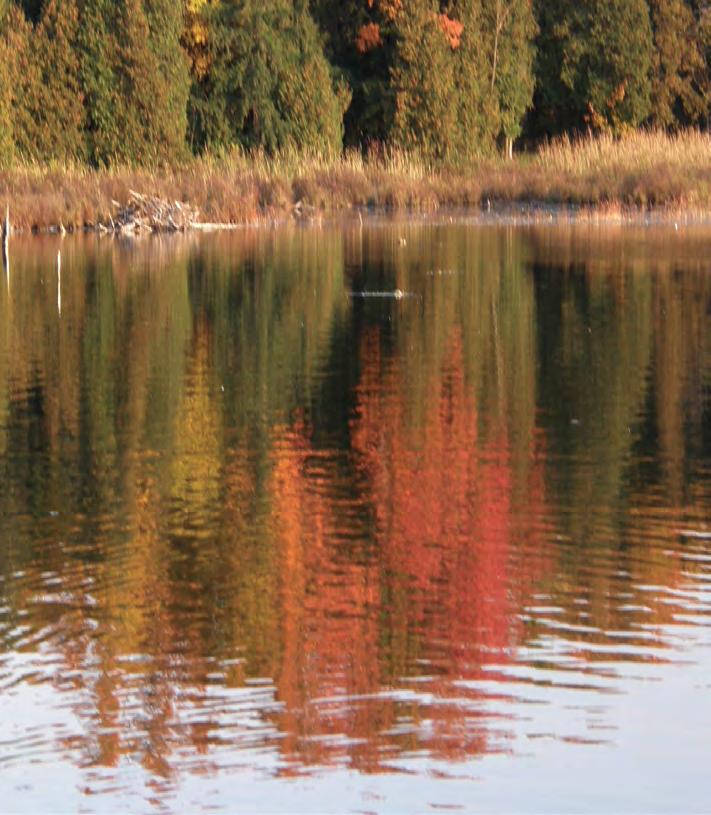
Jim’s Hand-tied Bucktail Jigs HOURS: MON. – FRI. 8 AM – 7 PM SAT. & SUN. 8 AM – 6 PM
1019 River Road Manotick, ON (613) 692-LINE (5463) info: manotickbaitsupplies@hotmail.ca
This barely scratches the surface of the amazing new and improved products being designed specifically with ice fishing in mind. There are many, many options available. We haven’t even touched on the great improvements being made to ice huts, augers, reels, line, etc. It would fill an entire whole issue, possibly more if we tried to cover everything. Hopefully this feature will give you a starting point and get your investigative juices flowing.

WWhen John D. Kreisser designed his K&K Animated Minnow back in 1906, I’m sure he had no idea of the number of manufacturers that would use his same concept more than a century later.
Considered the first jointed minnow, Kreisser’s lure was shaped from wood and featured glass eyes, a large metal tail fin and breakaway tandem hooks. Its unique hinging design was granted patent number 857,883 on June 25, 1907. According to the paperwork packaged with each lure, it was touted as “The Minnow That Swims!”
sizes, shapes and colours are currently available through most tackle outlets.
Why? Because they catch fish! And oftentimes, they catch the biggest fish.
There’s something about their true-to-life profiles and swimming action that triggers big bass to strike, or at least follow the lure to within visual range so that a secondary presentation can be made.
That could mean a second cast with the same bait, or the use of a follow-up lure – like a wacky-rig Senko or a flukestyle bait. And if a second attempt fails to produce, at least the fish’s general location is revealed for another try later – a strategy that’s commonly practiced among savvy touring pros.

on a lake where bass are targeting gizzard shad or large herring. When those are the primary forage, I know the fish feeding on them will usually be larger in size. So I’ll go to lures that range in lengths of six to ten inches (maybe more) and match my colour selection to the bait they’re chasing.

Among the best new hard-body entries is the Arma Joint 190SF swimbait by Shimano. I like this lure for a number of reasons.

First, it has a unique hinging feature that allows its body to fold completely in half, which aids in long distance casting. The idea is simple: Less bulk or resistance, the further the lure will travel. And with a collapsible profile, casting accuracy, too, is improved.
Evidently, sales for the Animated Minnow were good, as Kreisser expanded his offering to include other sizes and profiles, even some non-jointed variations were introduced. But that was then, and this is now. And who could have guessed the number of similar swimbaits that would follow more than 100 years later?
Swimbaits similar to Kreisser’s are so popular selection is virtually unlimited. Countless

They’ll make return visits to fish that reveal themselves, believing they will eventually bite. A practice that’s brought me success more times than I can remember – at places like Guntersville, Fork, Chickamauga and others. Big fish would track my swimbait only to refuse it, but later bite on a follow-up presentation with that lure or another.
While I catch the majority of my fish using smaller profile swimbaits, when I’m after big bass, I rely on larger profiles – like when I’m
Secondly, the Arma Joint will track true at any rate of speed. I can burn it just under the surface or give it a lazy, slightly deeper retrieve, knowing it will maintain a perfect upright swimming action.
But what I like most about the Arma Joint is how it does an about face when paused. The lure literally circles back in the opposite direction, as if it were confronting any would-be followers – an action that I believe forces big bass to strike, in a total reflex reaction. Sort of like hopping a bottom bait to make lethargic bass bite.
When a fish is tracking a swimbait and you pause the retrieve, oftentimes they will lose interest. But if that lure swings around and faces its attacker, predatory instinct takes over.
To throw big swimbaits, you’ll need the right tackle. We’re talking big rods and
continued from page 20.)
stout reels spooled with line heavy enough to withstand the repeated shock of casting heavy lures.
Most savvy swimbaiters use straight fluorocarbon rated between 20- and 25-pound test. Others prefer mid-range braid tipped with a fluorocarbon leader. Still others use straight mono. Whatever your choice, be sure it can handle the rigors of repeated casts with heavier lures, without hindering the swimming action of those lures.
For rods, I prefer Shimano’s Expride series in lengths of 7’ 6” inches to 8 feet, in heavy to extra-heavy actions. These rods are stout enough to handle the heaviest of swimbaits and can launch them a mile, yet they taper perfectly for the right tip action. I pair them with slightly larger than normal casting reels – like Shimano’s Tranx 300 or Curado 300K. These reels feature powerful brass gearing and large profile handles, which work to your advantage with big swimbaits – especially when winching big fish away from thick cover and into the boat.
So many fish are lost on big swimbaits, usually because they’re played too long. I know it goes against conventional wisdom, but from my experience, the longer you play a fish on a big plug, the greater its chances to escape. And that includes swinging them over the gunnel once they’re close to the boat... using their momentum, of course.
Although throwing big swimbaits can be fatiguing, the rewards are oftentimes huge. Throw them around cover and obvious features, like docks, laydowns, riprap and grass edges. If large fish are present, chances are good a big swimbait will pull them out of that cover. And remember; although they may not bite on the first cast, they’ll usually reveal themselves so that you can quickly follow with another presentation or try them again later.


Go here to see more on Shimano’s Arma Joint 190SF swimbait, and here to learn more on John D. Kreisser and his K&K Animated Minnow.

Editor’s Note: Bernie Schultz competes on the Bassmaster Elite Series and serves as a columnist to Bassmaster.com and InsideLine.net. He’s also an educator and promoter of angling, representing some of the biggest brands in fishing – including Mercury Marine, Caymas Boats, Power-Pole, Shimano, Fuji Rod Components, Garmin, Hildebrandt, Yamamoto, Power Pro, TH Marine & Don’t Die Lithium Batteries. Follow him on Instagram, Facebook or through his website, www.bernieschultzfishing.com


lbs. of perch. I’m not really sure if the perch are getting bigger or if we’re all just getting better at catching them!
This should come as no surprise to anyone but forward-facing sonar like Garmin’s LiveScope Plus is an absolute “Game Changer” when it comes to targeting lake Simcoe’s famed “Jumbo Perch”! During last year’s event my partner, Oliver Grigull and I, turned to each other numerous times and asked “Does it feel like we’re cheating?”




found in depths ranging from 4 to 30 feet of water! On Lake Simcoe, there is a population of perch that stay deep as 70’ – 90’ but unless you’re planning on keep all those fish for a fish fry, I don’t recommend targeting these fish. When you’re bringing them out of those depths, their air bladders blow up and it is hard for them to go back down if released!
LLake Simcoe is world renown for its “Jumbo” perch fishing through the ice and this winter was no different! Although good ice was slow in coming, when it got here it was here until almost April! Trust me Lake Simcoe is a world class yellow perch fishery all year long but by far the best perch fishing of the year is in the spring especially for true “Jumbo’s”! Many of Lake Simcoe’s famed jumbo yellow perch begin their spawning rituals beneath the ice and move towards their shallow spawning grounds as the ice starts to goes out!
There are literally spawning grounds all over Lake Simcoe, some holding larger schools and bigger fish than others. Usually around the 3rd week in April, the Mark McKeown Memorial Perch Open is held in memory of Mark who was a long-time member of the CBAF. Don Sheldrake and I managed to win the first time that this tournament was held weighing in over 21.5 lbs. on 15 jumbo perch. The crazy part of that day was I wasn’t sure that I had weighed in our 15 heaviest fish as we had so
With schooling fish such as yellow perch, the key is to find the big girls and with LiveScope, it is only a matter of time! Once you are able to find them, then they’re usually fairly cooperative. Not only does LiveScope aid in finding the fish, it is also very useful in determining the mood of the fish.

As with almost all types of fishing these days, electronics are playing a larger role in locating fish particularly with schooling species such as perch. You can drive around on your main engine until you start marking fish on your traditional Chirp sonar, then deploy your LiveScope to zone in on
Water clarity plays a big role in how these Perch set up and what kind of feeding mood that they’re in! If you can find water with a bit of colour in it, those areas will tend to be a little warmer and the fish will be more active there! 45 degrees F is the temperature benchmark where these fish really start to stack up and do their spawning duties!
(Continued on page 23.)
life-like action that fish can’t resist.









• Fish bite and keep biting, cast after cast - even on pressured fish.






There are lots of great presentations that will work on these massive perch at this time and of course live bait such as emerald shiners always work. A standard dropshot rig works great with any type of live bait that you may wish to try! Just make sure that you obtain your minnows in the proper Fishery Management Zone and keep your receipt in case you’re stopped by the MNR/ OPP or York Regional Police. All 3 agencies will enforce any regulation violations!
Because of the size of the yellow perch that we’re targeting, I recommend at least 7’ ML power rods like the Daiwa Aird-X models, which are great value. Pairing one of these rods with a 1000/1500 sized spinning reel spooled up with 6-8 lb. test braid and a 4-6 lb. test fluorocarbon leader and you’ve got a perfect “Jumbo Perch” outfit. The longer rod allows for greater casting distances and you’re also able to take up a lot more line when setting hook!
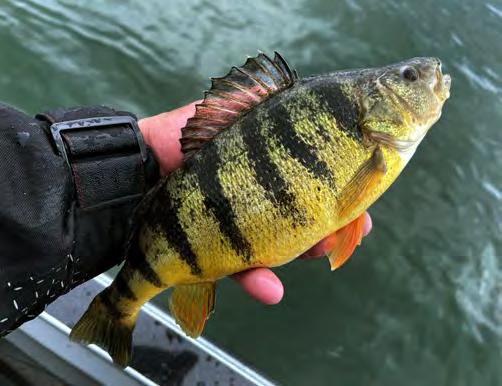
My go-to is some type of jig, I like to combined an 1/8 oz. Ultra Tungsten ball jig with either a 2 1/2” Z-Man GrubZ, a Grumpy


Bait Company Mini Goby or a Great Lakes Finesse Drop Minnow. I generally stay with natural colours, although there will be those days when the bright chartreuse, pinks & oranges will slay’ em! Sometimes running a “Donkey Rig” similar to one that we run for ice fishing will get you numerous double headers. On the top hooks, a Mini MinnFIN or Micro Grubby from Grumpy Bait Company work great as well as creature baits like True North Baits, Mini M’eh Fly!
If you happen to locate fish over 10’ –15’, virtually any ice fishing presentation

will also work, McGathy’s Slab Grabbers, Clam Tikka Minnows and Rapala Jigging Raps! You can vertically work these lures and stay on top of these fish. Literally you’re ice fishing without the ice! Mini Tube Jigs, which can mimic a goby or a crayfish can also be very effective especially when you’re fishing deeper. The Great Lake Finesse Mini Pro Tubes work great combined with a naturalcoloured tube.
The new Z-Man line-up of Micro Finesse baits are going to be deadly on the Lake Simcoe “Jumbo’s” The system is made up of 5 different ElaZtech baits, the Micro TRD, Tiny TicklerZ, StingerZ, Shad FryZ & LarvaZ in a wide variety of fish catching colours. The Micro Finesse SchroomZ jigheads ranged from 1/10-1/30 oz. and are available in black, glow, chartreuse and red! The buoyancy of the ElaZtech composition of these baits will cause them to stand up off the bottom like a Ned Rig!

If you’re trophy hunting and possibly trying to catch a new Ontario record Yellow Perch, I find that there are definitely some “Big Fish” lures/presentations. While you may not catch as many fish on these lures, your chances of catching a true “Jumbo” are usually better! The Great Lakes Finesse Sneaky Underspin combined with a Z-Man Slim SwimZ or GLF Drop Minnow is definitely a “Big Fish” package. They’re available in 3/16 & 5/8 oz. models, which will allow you to slow roll them through those deeper depths!

(Continued on page 26.)

(Jumbo Perch continued from page 25.)

Another great “Big Fish” lure is any type of Beetle Spin type lure! You can make these up by attaching a safety pin style spinner with a Colorado blade to an Ultra Tungsten jighead or a Great Lakes Finesse Stealth Ball Jighead. Much like the Sneaky Underspin, it is a strictly a “Chuck N’ Wind” presentation, which enables you to cover a tremendous amount of water! While covering more water, you’ll be presenting it in front of a large number of big females who usually are not shy when it comes to feeding while they’re spawning.
An underutilized lure is an inline spinner, smaller Mepps & Vibraxes in sizes #0-2 are especially deadly when you tip it with a minnow or a worm! Make sure that you use a quality snap swivel like Stringease’s SS Crane Swivel to help battle the line twist that these lures create. When you’re not tipping your lures with live bait, it never hurts to cover up the human scent with a dab of Liquid Mayhem. Being a gel scent, Liquid Mayhem adheres to your lure for a long time. Use your favourite confidence scent, two of my favourites are the Garlic Crawfish and Shad scents.
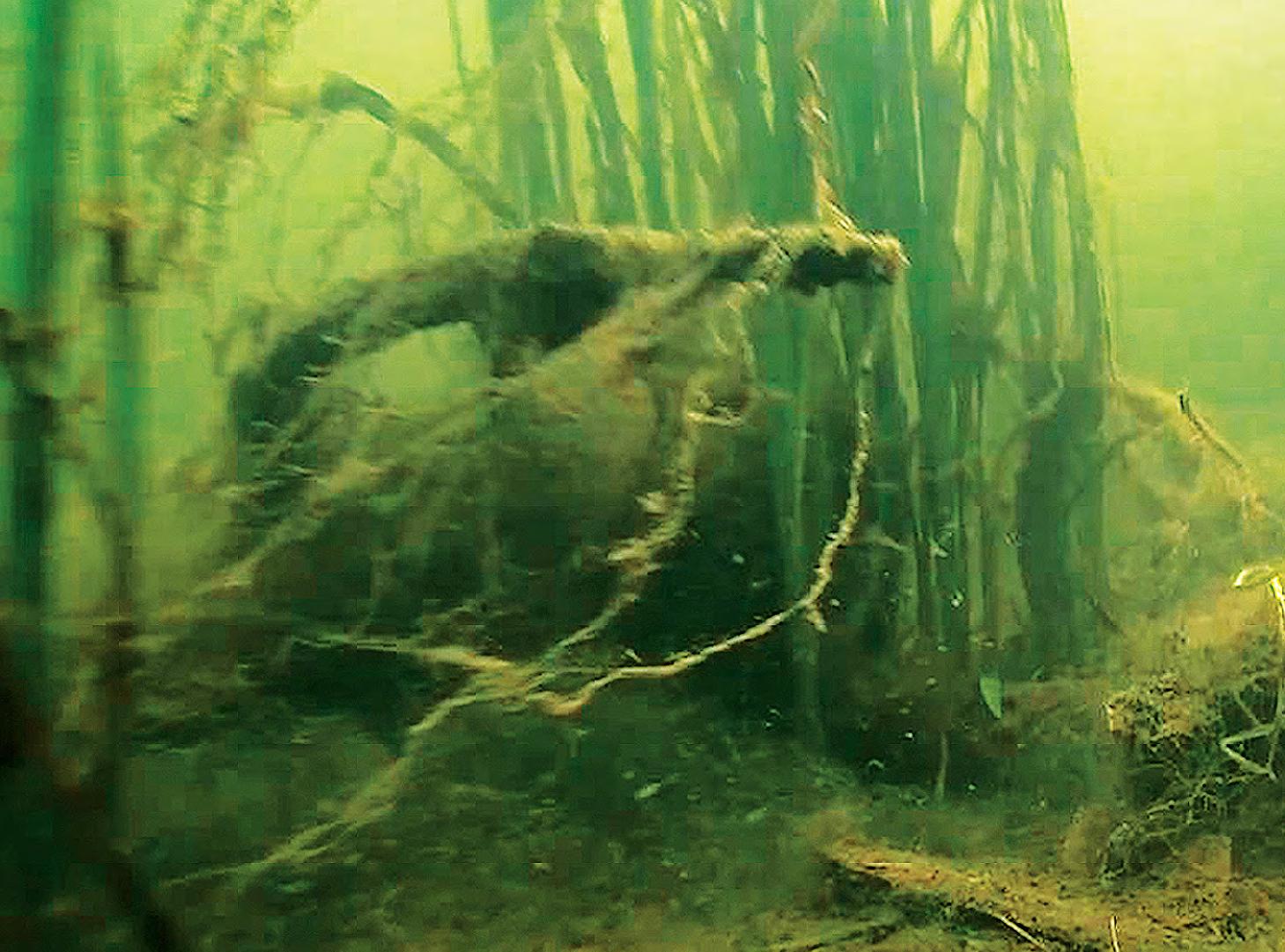
If this past ice fishing season is any indication, I expect that this spring will be a banner period for big “Jumbo’s” We’ve seen a great deal more big fish this winter than in the previous couple of years! Not really sure if this is part of a cycle or what but we’ve seen quite a number of 15” plus fish caught through the ice with rumours of a few over 17”! If you happen to catch one of these unicorns during the spawn, you
David Chong is widely recognized as one of Canada’s top competitive tournament anglers. He is also an avid multi species angler and is a strong advocate for affordable, accessible angling for all! David loves sharing his vast fishing knowledge and stories with anglers of all ages, beginners and pros alike!




It senses the bottom and delivers the perfect hold. It knows when wind and waves threaten to knock you off your spot, and re-anchors automatically. It’s built to last, built to fight and built to keep you in the game until you get what you came for. This is Raptor. And it’s only from Minn Kota®
minnkotamotors.com/Raptor











off the bottom to wait for the strike. Pounding the bottom too much will call the sturgeon to bite.
I use Sunline SX1 green braided line. Its thin diameter cuts the water with an 8 lb Sunline FC fluorocarbon leader that’s super clear and abrasion-resistant. I wear Fish Monkey Stealth Dry Tec gloves and never have to take them off when baiting minnows on jigs; they are thin, waterproof and warm. Northland Whistler jigs and Thumper jigs with a rainbow or a frozen shiner work extremely well. With Whistler jigs, use short pulls forward with your rod tip and let it drop back for about 3 or 4 seconds. The next time, repeat the motion but let out 3 to 4 feet of line. I call this walking the dog downstream. I would rather not hook a big walleye too far from the boat downstream so I reel in the Whistler jig and start vertical from the boat and then repeat the downstream walk.
Jigging with Humminbird

MEGA Live Imaging in forward viewing mode will prepare you as the walleye approaches your jig. St. Croix Legend Elite 7’ Medium Extra Fast is the Cadillac for this jigging approach. On windy days, I shorten up to a 6’ for less wind drag on the rod tip.
In the Spring rivers are traditional destinations to shake the postwinter cabin fever out of your blood. Meet with friends and family for a remote northern getaway. Get on the water for walleyes. Gather around the campfire and share stories. Many anglers have been fishing here since they were kids because their families have been coming here for generations. And you never know if Old Man Winter will stick around or if Mother Nature has something else in mind.
I have seen people trying to launch boats that are frozen to their boat trailers because the air temperature is in the single digits. I have also seen summer-like weather and sunburned faces. Whether there is a snow squall or a heatwave, you will find Heather and I chasing that 30-incher on a river somewhere in April. Good luck!
Follow, like and share my fishing adventures on YouTube, TikTok, Twitter, Instagram and Facebook!


About the Author: Brian “Bro” Brosdahl, is a fishing guide and promoter. One of the most recognized and respected anglers in North America – Bro, as he’s known, is a multispecies angler best known for his influence on the sport of ice fishing. He can be booked for guided trips at: bbro@paulbunyan.net or brosguideservice.com.

fish. As a scientist I have much to learn from anglers and anglers can certainly learn from scientists, but those interactions are unlikely to help anyone catch piles more fish! To say that I am a frustrated angler is an understatement. There are days – and we all have them – where I simply can’t get a bite. I have all the necessary equipment, I read all of the blogs and magazines, I spent 11 years doing university level education mostly focused on fish, and for the last 12 years I have been a professor of fish biology.
Yet, I think what matters most is time on the water. I can look at a water body and say – wow, that looks like text book bass habitat – and not catch a thing. And then throw a random cast and hook a bass where they “aren’t supposed to be”. I think that is another key message – fish don’t necessarily follow the rules.
Sometimes it is just better to go against the flow on a river. To get bites in any condition, try slow dragging a 2 to 3 oz. bottom bouncer with a Northland Butterfly Blade Harness and a minnow or a crawler with a simple bead on a short 2 to 3 feet of Sunline FC fluorocarbon leader with a Gamakatsu Finesse Wide Gap Hook. Big walleyes can’t pass up a fat rainbow sucker minnow or creek chub slowly dragging upstream on the edge of a current seam at .5 mph. This will create strikes. Just remember, its bottom bouncing and not bottom dragging. Touch the sinker on the bottom every now and then to make you are near the bottom. This is a great approach after a cold front or if the river is murky. And there are times when crankbaits just work better on rivers. I keep my rod locker ready with Northland Rumble Shiners on St. Croix Eyecon trolling rods ready to deploy.
Jason Matity & Jeff Matity are helplessly, hopelessly addicted to the sport of fishing. The only thing they like better than catching big fish is helping others catch big fish. Whether it’s trolling for northern pike and walleyes, to jigging for trout, burbot and perch, pitching jigs to bass, or dunking crawlers for carp and catfish, they are Saskatchewan’s multispecies fishing authority whether on ice or open water. Matitysgetfishing.com
The underwater world holds many mysteries that fascinate me as a scientists and angler. Sometimes that fascination can lead to some minor frustrations when I can’t figure out where the fish are or how to get them to bite – but that is what keeps me coming back for more!

Rainy River can get extremely rough at the Gap, Four Mile Bay or the long straight stretches where the northwest wind blows. I have spent many days fishing in rough water during cold weather and it’s hard to beat a windshield this time of year. This is one of the many reasons I choose a Lund 2075 Pro V boat with a Mercury 300 Pro XS for guiding, tournaments and fun fishing anywhere, anytime. I stay comfortable all day, no matter the winds and the waves. When the struggle is real, Spot-Lock into the wind and hide behind your windshield!
Dr. Steven Cooke is a professor and Canada Research Chair at Carleton University (www.fecpl.ca).
He is also a Science Ambassador for #Keepemwet Fishing.

I have an AFTCO Barricade rainsuit and, even in the rain, I am dry as a cork. I know I am not the only one who fishes in inclement weather. I have witnessed many anglers boat big walleyes at the same time I am!


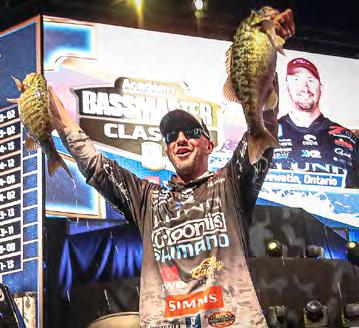

CCanadian pro Jeff “Gussy” Gustafson’s bass refused to play fair on the final day of the Academy Sports + Outdoors Bassmaster Classic presented by Toyota on the Tennessee River. But fortunately for him, the bulk of his work was already done. Despite catching only two smallmouth bass that weighed 6 pounds, 12 ounces on Championship Sunday and falling three fish short of the 15 he’d been counting down toward all week, Gustafson held on to win the most treasured title in professional fishing with a three-day total of 42-7.
As the first Canadian Classic champion ever, he takes home the Ray Scott Trophy and a $300,000 first-place check. “I had an hour ride back to check-in, and it was horrible,” said Gustafson, who now holds two-straight wire-to-wire victories on this fishery. “I thought I’d blown it for sure. I thought there was no way I’d even be in the mix. “When I got back and looked at BassTrakk, I still wasn’t sure. I knew I didn’t have much more than what mine said and the guys behind me both had limits that might have been heavier than what they had entered.”
As it turned out, Gustafson received hard charges from both Maryland pro Bryan Schmitt & Alabama pro Scott Canterbury, but neither could quite pull it off. Schmitt caught a five-bass limit that weighed 11-1 and finished less than 2 pounds shy of a win at 40-14, while Canterbury caught one of the biggest limits of the day at 12-1 and finished just over 2 pounds back at 40-1.
Gustafson spent the day in Tellico Lake doing the same thing that had worked for him six days in a row on the fishery – four during his 2021 regular-season Elite Series win and two to start this Classic –but something was different. Though plenty of smallmouth were still visible on his Humminbird MEGA Live electronics, they simply weren’t as cooperative as they had been previously. “I think it was a combination of they’ve been getting fished hard and there’s some heat coming and they’re ready to move up and spawn,” Gustafson said. “I’ve been working them pretty hard, and you could tell they were lazy. “The last couple of days, they would just skyrocket up to the bait when they saw it. But today it wasn’t like that at all.”
After catching 18-8 on Friday and 17-3 on Saturday, Gustafson didn’t catch his first keeper until around 9:30 a.m. Sunday. Then it was another three hours before he caught his second and final keeper – and by then, he had unofficially lost the lead on BassTrakk. But in the end, his “moping” tactic won out. A technique that dates heavily back to his Canadian roots, Gustafson used a Z-Man Jerk ShadZ in the smelt colour on a 3/8-ounce Smeltinator jighead with a 1/0 hook, fishing straight down for bass he could see on his Humminbird MEGA Live forward-facing sonar. He fished the rig on a G. Loomis NRX+ 872
rod – a 7-foot, 3-inch medium action rig – with a Shimano Stella 3000 spooled with 10-pound PowerPro and a 10-pound Shimano Mastiff fluorocarbon leader.
He said the angle of the bait was key to many of his bites. “I use a knot called a San Diego Jam or a three tag-in knot,” he said. “You can really tie whatever knot you want, but you want that bait to sit horizontal and natural in the water. “I’ve been using that Z-Man Jerk ShadZ for years – long before they sponsored me – just because I feel really comfortable with them and they work.”
As for the action he was imparting to the bait, he said every fish was different. “There’s no real jigging,” he said. “It’s more of a quiver. If they’re kind of eyeballing it, coming slower toward it, I just give the bait a little bit of a quiver.”
Sometimes Gustafson said he “plays games” with finicky fish. “When they’re coming slow, I pull it up away from them a little bit sometimes,” he said. “You get a lot of bumps, too, where they hit it with their mouths closed. When they do that, I drop it back down and start the quiver like it’s an injured baitfish.”
Gustafson said he relied heavily on his Minn Kota Ultrex trolling motor to stay on top of the fish, especially on Day 2 when the winds topped 20 mph. “Spot-Lock is one of the greatest things ever invented,” he said. “Every time I’d catch a fish before I’d even put it in the livewell, I’d hit Spot-Lock because, a lot of times, there were other fish following it. So, Spot-Lock kept me on them.”
Still, he said MEGA Live was the key to his event. “I know everyone doesn’t love the forward-facing sonar, but it’s mandatory equipment if you want to compete with these guys. Everyone has it, and if you don’t, you’re not even gonna come close to competing.”
The magnitude of being the first Canadian to win a Classic trophy was still dawning on Gustafson 30 minutes after the trophy was placed in his hands. “It’s insane,” he said. “I’m kind of speechless. I wish I could have spoken a little better up there on stage. There are a lot of good anglers up there, a lot of people who love bass fishing in Canada. “So, this is for everybody up there.”
The 2023 Academy Sports + Outdoors Bassmaster Classic presented by Toyota set a new record, welcoming a crowd of 163,914 fans to Classic Week activities. Gustafson claimed the $7,000 Rapala Monster Bag of the Week with the 18-8 limit he caught on Day 1.

IIn keeping with its mission of celebrating the sport of bass fishing, the Bass Fishing Hall of Fame Board of Directors will be honouring “Big” Jim McLaughlin from Seeley’s Bay, Ontario with its special ‘Meritorious Service Award’ during its upcoming sponsor/ donor reception at the Bassmaster Classic in Knoxville. Established in 2018, the Hall’s Meritorious Service Award gives proper and well-deserved recognition to an individual or organization for their significant contributions within specific areas to bass fishing.
McLaughlin, known throughout the Canadian bass fishing scene as “Big” Jim, was once one of the most feared and successful competitive anglers in Canada, as well as its first Pro Bass Classic winner and the first twotime Pro Bass Classic winner. He continues to be a headline presenter at major fishing expos in Ottawa and Toronto, along with handling emcee duties at various bass fishing tournament throughout Ontario.
In addition to his angling skills, McLaughlin has always had a knack for introducing youngsters to fishing and helping their parents understand the sport and how to make it a family activity. Over the past 25 years, he has given many kids their first taste of fishing by hosting the Jackpot Casting Pond at the annual Ottawa Boat & Outdoor Show. Over his career, he’s been a driving force behind growing tournament bass fishing in Canada and has inspired many to establish careers in the sport as both professional anglers and in other areas within the industry.
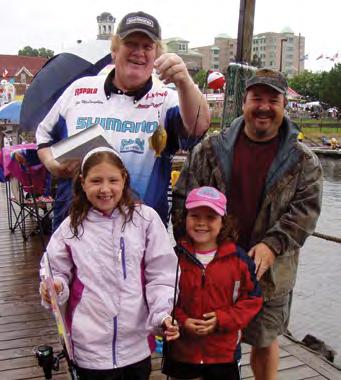

“While “Big” Jim’s incredible tournament accomplishments are what most bass anglers in Canada would point out, it’s his relentless and tireless work promoting bass fishing that really overshadows all his tournament success,” said noted bass fishing TV celebrity Dave Mercer.


“There’s a Greek proverb that says, ‘a society grows great when men plant trees whose shade they know they shall never sit in’ and
“Big” Jim is doing that by physically introducing more anglers to fishing at tournaments, outdoor expos, kid’s events, or often a random lake side meeting, than any other Canadian.”

McLaughlin joins the late Ronnie Everett and Jim Hooven as well as the Western Bass Club as recipients of the Hall’s Meritorious Service Award. “On behalf of the BFHOF Board, we can’t thank “Big” Jim enough for what he done for bass fishing and the tournament scene throughout Ontario over the years,” said Board president John Mazurkiewicz. “It’s a pleasure recognizing him for what he does to celebrate, promote and preserve the sport of bass fishing.”
Many BFHOF inductees, the Hall’s Board, leaders from the bass fishing industry, pro anglers and special invited guests will be in attendance at the annual HOF reception on March 23 at the Bassmaster Classic where McLaughlin will officially be honoured with his BFHOF Meritorious Service Award.

More information about the Bass Fishing HOF and its mission of ‘celebrating, promoting and preserving the sport of bass fishing’ is available at www.BassFishingHOF.com, or by contacting BFHOF executive director Barbara Bowman at bfhof.barbara@gmail.com.

The Bass Fishing Hall of Fame exhibit, located within Johnny Morris’Wonders of Wildlife Museum and Aquarium adjacent to the Bass Pro Shops’ flagship store in Springfield, Mo., showcases more than 80 individuals who helped shape the sport of bass fishing and have been enshrined in the Hall. Information on visiting the 350,000-square-foot Wonders of Wildlife Museum can be found at www.wondersofwildlife.org

Wlive and the forage they eat. When these species are sharing the same area, it’s not uncommon to catch a walleye on one cast and a pike on the next. Catching a mix of these tenacious, toothy fish can be a lot of fun, so with this in mind here are some dual-purpose tactics for anglers keen to target walleye and pike simultaneously.






With a mouth full of sharp teeth, northern pike can easily cut through light lines commonly used for walleye presentations. Pike bite-offs are a big gripe with anglers. Who likes losing lures, right?

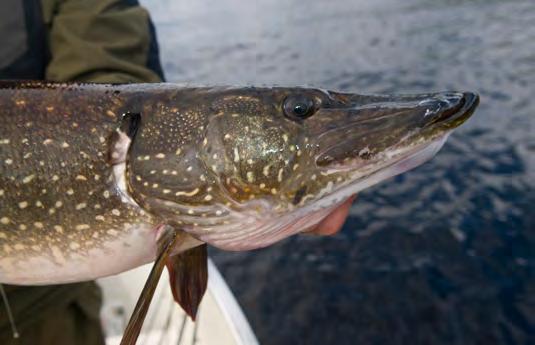
The simple solution is adding a leader to a walleye presentation when you’re in pike territory. I use a few different set-ups, depending on the scenario. When I’m primarily fishing for walleye in clear lakes where any pike catches involve small to medium sized northerns, I tie a 20- or 30-pound fluorocarbon leader to 15to 20-pound braid. If I’m trolling crankbaits for walleye, I use a 40-pound fluorocarbon leader with a swivel and snap on each end.
By: Tim AllardIt’s uncommon for a 5-pound pike to chew through a fresh fluorocarbon, but it’s critical to be regularly checking for damage and tying on a new leader at the first sign of trouble. This setup works for jigs, bladebaits, Rapala Jigging Raps, and swimbaits fished on medium- to medium-heavy rods.
On waters where there are higher odds of encountering larger pike or frequent northern catches, I use wire leaders. Pre-made leaders are easy to find at tackle stores, but I prefer using thin, knot-able single strand wire for most presentations with the exception of large pike baits.
My experience is mainly with 18and 25-pound Knot 2 Kinky. This nickel-titanium wire is bite-proof, kink resistant, easy to tie, stretches about 10%, and is ultra-thin, so you don’t have to worry about refusals from line-shy fish. American Wire’s Surflon Supreme is another popular tieable wire option.

When I’m casting upsized plastics and hard-baits on medium-heavy or heavy rods for big pike, I use stronger fluorocarbon in clear water and wire leaders in murky conditions. These leaders are overkill for walleye, but the hardware doesn’t impact landing those fish and, more importantly, are intended to ensure large pike make it in the boat.
There are many bait options for those wanting to maximize walleye and pike catches on any given day. Jigs rank high on my list as walleye are often bottom-oriented. Pike also relate to the floor or, at the very least, are aware of forage scurrying along bottom.
A bucktail jig is a great pick. A quality bucktail will take plenty of abuse from toothy pike and walleye. Ruggedness also makes bucktail (Continued on page 34.)

Welcome to the top. The new APEX™ Series showcases the clearest sonar imaging on the sharpest multi-function display the water has ever seen. Industry-leading MEGA Imaging® and Dual Spectrum CHIRP sonar come standard, with even more performance from a dedicated sonar channel for accessory transducers up to 2kW. See it all clearly with a full-HD touchscreen, and add the power of the One-Boat Network™ for unrivaled control of your vessel. Find out if you’re Type APEX at Humminbird.com/APEX


APEX 19
APEX 16
APEX 13
jigs great for ripping around vegetation edges, which are common hunting areas for both species.
“Big” Jim’s bucktail jigs have caught be a lot of pike and walleye over the years –and I’m not just staying that because he’s the publisher of his magazine. Ask around and a lot of bucktail jig aficionados will tell you the same.

When focusing on walleye and shallow pike, a 3/8-ounce jig is my go-to for casting deep weedlines, flats, and sand bars. For fishing pike in mid to deep areas and when using faster retrieves, use 5/8-ounce or heavier jigs. Adding a plastic worm, minnow, or swimbait trailer bulks-up a bucktail, and adds action and scent. Generally, I prefer to fish a bucktail with an aggressive snapping retrieve to trigger a reaction, but working these versatile jigs slowly will also fool either species and can sometime be a better play in cold water.
A jig paired with a four to five inch swimbait is another reliable presentation. Steadily swimming the bait just off bottom drives walleye and pike crazy.

Minnow profiled plastics are excellent for walleye & pike. The Berkley Fusion19 Snap jig gives a minnow plastic a gliding action on the fall, triggering strikes from both species.
the jig allows for a slow retrieve mixed with pauses and lazy drops to bottom.

Similarly sized forked-tail minnows and soft jerkbaits (aka jerk shads) on jigs are another option. The thin profile and wispy tail of these plastics drives walleye and pike crazy. A liftfall retrieve along bottom is hard to beat. Some days fish want an aggressive snap, other times a moderate lift is better. Likewise with fast versus slow drops. This combo is equally good for vertically jigging.
Tip: Adding a drop of super-glue to the nose of a swimbait or jerkbait before pushing it up against a jig improves the plastic’s durability and lifespan.

Walleye and pike will readily strike minnow and shad profiled minnowbaits and crankbaits when worked along shorelines, weed edges, and structures. Carry a mix of shallow to deep-running lures to work different depth ranges.
A collection of 1/2- to 1-ounce swimbait jigs covers most shallow to deep scenarios with bulky swimbaits. I use 3/8-ounce jigs for slim swimbaits for fussy walleye abiding in 8 to 18 feet. Lightening up on
Bladebaits, lipless crankbaits, and spoons are effective when jigged vertically over deep structure and flats where walleye and pike are feeding on baitfish. Casting spoons to shorelines, weed edges, and drop-offs is a well known pike strategy that is just as potent at putting walleye in the net.

(Continued on page 36.)











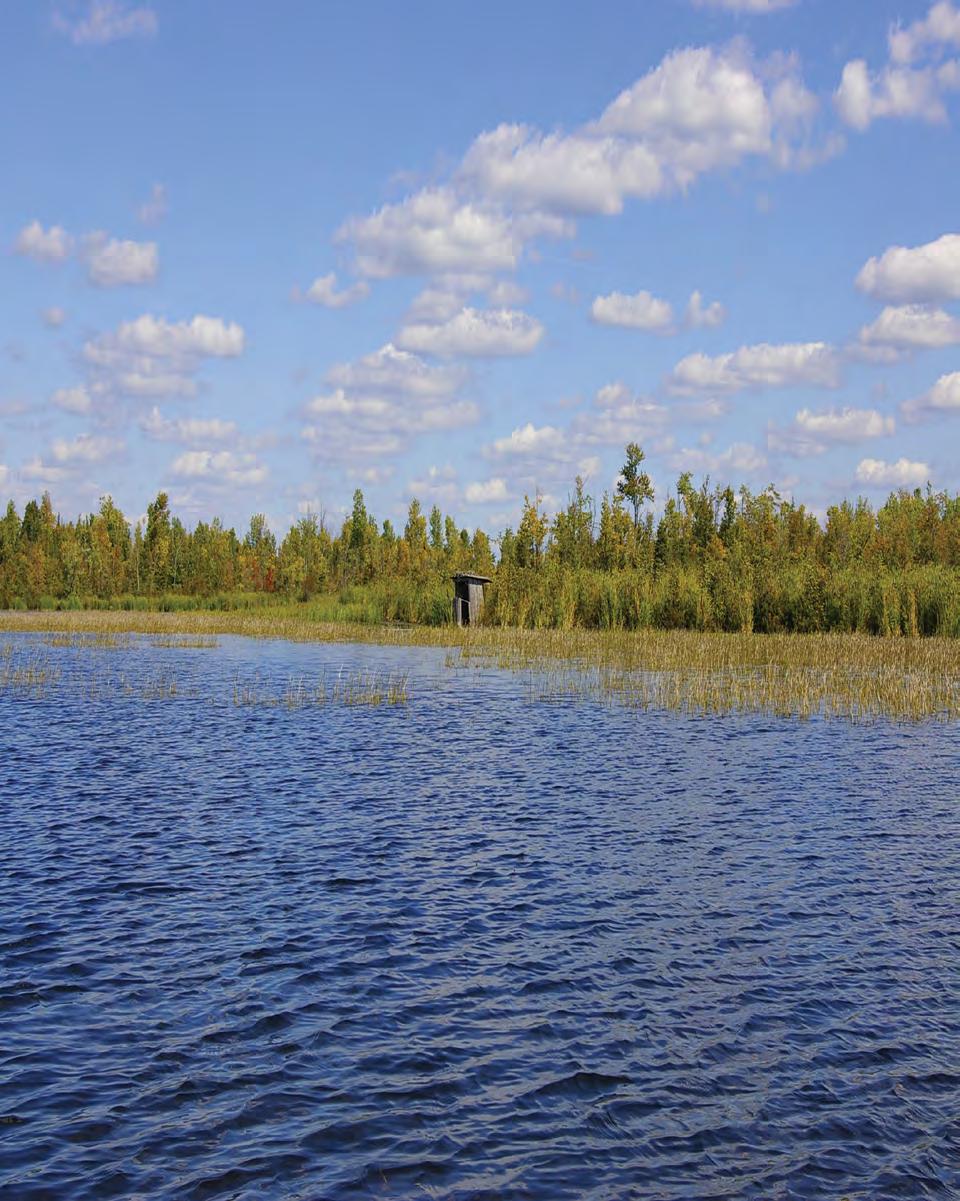









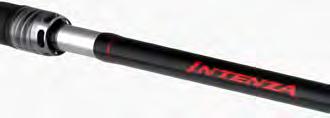











Focusing efforts on locations within lakes and rivers where walleye and pike mingle delivers good odds of hooking either species. While some spots have already been mentioned, here is a closer look at these locations and other areas worth trying.
When sunny conditions shutdown the walleye bite, catches a bunch of pike this size was blast for my friends and I a couple years ago in May.
Shorelines are popular early-season locations. In spring, these zones warm quickly, attracting baitfish and predators alike. An ideal scenario for catching both species is finding rock and gravel walleye spawning sites close to pike spawning areas, such as large bays, marshes, and tributaries.
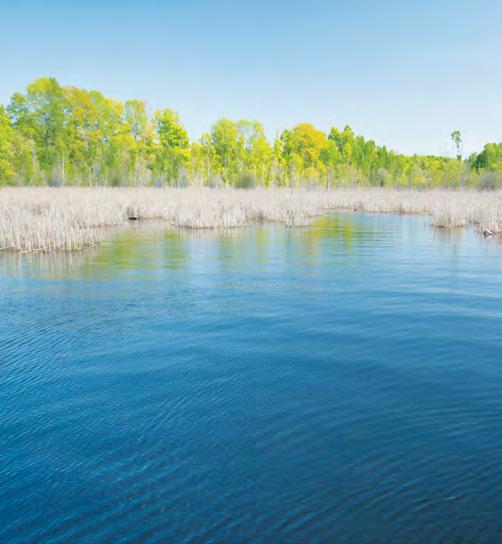
In spring, it’s common for either species to be between the bank and the first drop-off. During cold fronts or after several weeks of spring, fish may position on the drop-off, just beyond the break on mid-depth flats, or around the second drop-off. Keep in mind, too, certain conditions may concentrate fish in one area or depth range, and other times both species may be scattered.
Anglers should also be on the lookout for wind-blown shorelines throughout the season. Walleye and pike will take advantage of the tumultuous water conditions from waves blowing into the shallows to hunt prey. Shorelines are also common hunting territory at twilight and during overcast conditions.
Casting a jig to the shore, then hopping it along bottom towards deeper water has put a lot of walleye and pike in my boat.Trolling and casting shallow-running minnowbaits is another effective way to fish these areas.
Walleye and pike are frequently attracted to structures extending into deep water, like points, bars, and river wing dams. Both species use these push-outs as travel routes between deep and shallow water. Large points, bars, and wing dams also act as resting and feeding areas.
Casting or trolling crankbaits along the drop-off ledges and across the top of these structures is a reliable tactic. Vertically jigging various baits is another option and a good way to dissect specific spots, such as river current seams occurring around these structures.
Walleye and pike are regularly found together in and around vegetation. Sometimes both species are orienting to deep weed lines. Another scenario is species are relating to different spots, such as walleye relating tight to a weed edge and pike holding within a cast of deeper water along a drop-off.
Always look for turns and points along weed edges. These features collect fish. Understanding how walleye and pike are relating to weeds helps you choose effective presentations and keep your lure in the strike zone. For example, when there’s several feet between the weed tops and the water’s surface, yo-yoing a lipless crankbait or swimming a swimbait over the top of the vegetation will trigger walleye and pike holding within weedbeds.
(Continued on page 38.)
Sidebar:


The commotion from hooking and fighting a big pike may temporarily put resident walleye in a negative mood. Anglers having difficulty getting bites after landing a feisty pike are wise to leave and try another spot.

This might mean making a short adjustment within a large flat or making a bigger move and going to fish a completely different piece of structure.
There’s always the option of revisiting the original location after a couple hours to try your luck again.

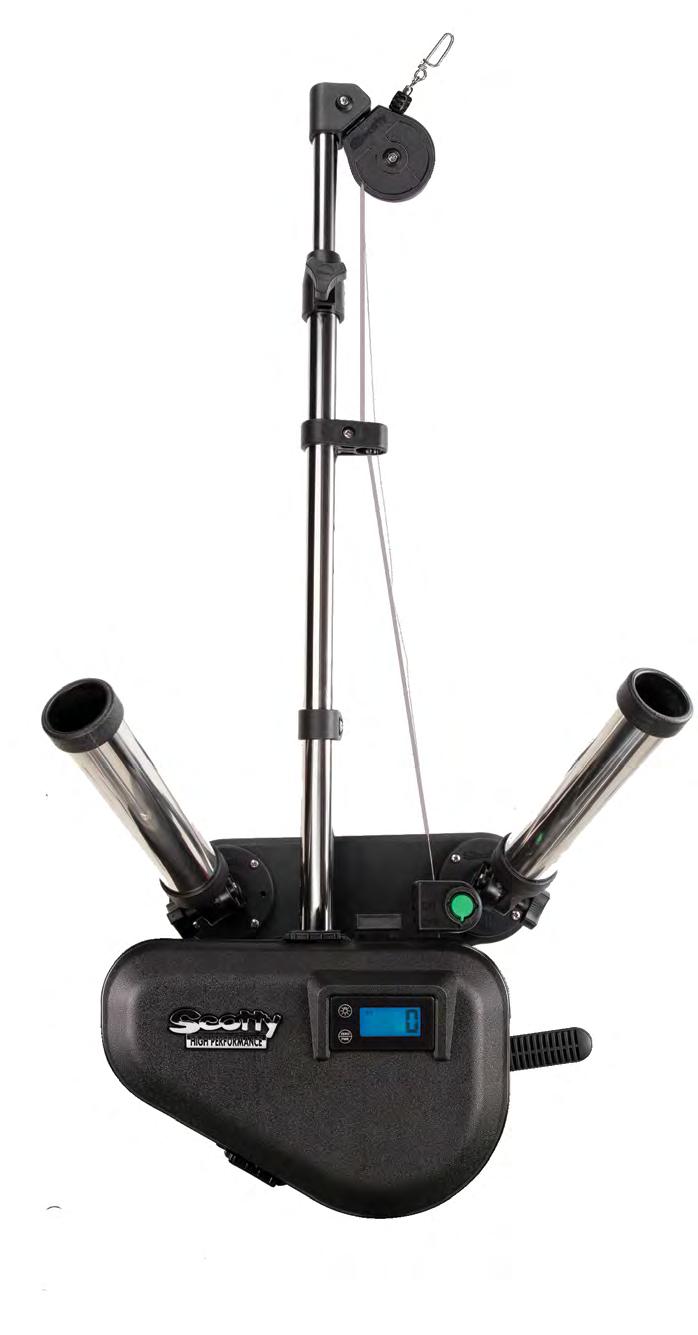
Walleye and pike can also be caught trolling minnowbaits and crankbaits. This includes running a bait over the top of weeds, along a deep weedline, or through water just beyond the weed edge.

I’ve had some incredible days fishing flats where pike and walleye were feeding on yellow perch and other baitfish.
While flats by nature are fairly uniform areas, there will be specific features where fish congregate. Examples include isolated rock piles, patches of grass, a slight depression in bottom, where a point extends off a flat, and the ledge where the flat drops into deep water. Cover water until you figure out what spots are holding fish. Then dissect these zones by experimenting with different lures and trying different casting angles to maximize the number of fish you catch.
On large, deep lakes, walleye and pike frequently relate to deep, mid-lake structures and feed heavily on cisco, smelt, and other open-water baitfish. These locations typically begin producing in early summer as lake temperatures warm, prompting some populations of walleye and pike to leave shallow areas for deeper, cooler water.


Casting jigs is productive on deep, sandy humps and other structures with minimal snags. Craggy, rocky bottoms are another matter. These are better fished vertically jigging a spoon, bladebait, or a soft-jerkbait on deep structure.
Trolling a deep-diving crankbait is another good strategy and an effective way to cover a lot of water. Pulling the bait through deep water and then across the top of a hump can trigger strikes.
(Continued on page 39.)
(Pike & Walleye Mashup! continued. from page 38.)
If this doesn’t work, try trolling over the drop-off while following the structure’s perimeter.




Up to now, I’ve focused on tactics and areas offering equally good odds of catching walleye and pike, but there’s another option. With this approach, anglers target walleye when they’re most active at dawn and dusk, and focus on pike during the day. This isn’t to say you won’t experience some incidental catches of either species at different times throughout the day.
On waterbodies home to both walleye and pike, there’s no need to choose fishing for one species over another. Using the tactics, baits, and locations suggested above, you can catch both species and, in turn, experience more consistent, action-packed angling.


About the Author: Tim Allard is a full-time, award-winning outdoor journalist and author/ photographer of the book, Ice Fishing: The Ultimate Guide. He’s a regular contributor to numerous North American print and online publications. From panfish to northern pike, Tim fishes whatever he can, whenever he can.
than a straight spoon. Watch a lure’s action while jigging it just beneath the ice to learn what works best for specific baits.



The above said, remember to follow the lure down with the rod tip, keeping a slight bow in the line, to keep aware of how the bait’s behaving. More specifically, being able to detect a strike as well as know when a lure touches bottom.






As mentioned at the opening of this article, flashy horizontal lures are deadly for walleye. I have a hard time putting a Rippin’ Rap down when I want to cover water, attract fish, and trigger reaction strikes. In addition to the gold model, I’ve also had success with a few of Rapala’s new custom colours, like Fruit Bowl and Leprechaun, which feature various coloured metallic accents.



Walleye also love metallic jigging minnow. A chrome-blue Rapala Jigging Rap is a reliable choice when walleye are foraging on silvery sided baitfish, like ciscoe and smelt. There’s also something about a gold-olive Rapala Snap Rap that makes big walleye get hungry.

Just Fishing . 30
DDoug Stange hosted an In-Fisherman TV segment that shattered the myth that walleyes are a timid fish, requiring live bait and finesseful presentations. That was over 25 years ago. Doug employed a 5” Berkley saltwater swimbait to wallop big walleyes along a weedline. I immediately invested in some 5” baits!
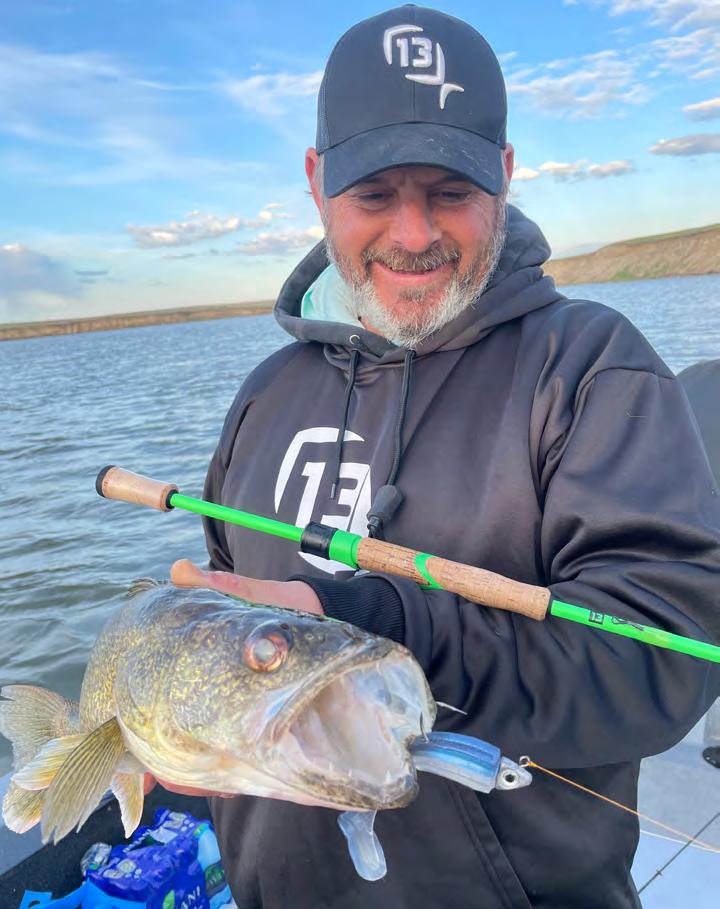


on a 1/2 oz. Hammer Head jig. I tied it on and let it fly. “In this 8’ water, the fish are either suspended or feeding towards the surface,” I concluded, “Tom’s Rapala cannot be getting down any more than 4’ or so.” Keep it up and bring it in fast, I thought, mimicking Tom’s jerkbait, as my other companions, Gerald and Mark, searched for more Rapalas.
I peered intently down my lime-green Berkley superline for the first glimpse of my bait and any following fish. From above, the silvery sides of the swimbait flashed impressively as the bait came into view. I stalled my retrieve and watched the bait hustle towards the bottom. Then, I found out why the bait is called the Big Hammer! A 27.5” walleye, very big for this far North, came out of nowhere, lunged forward and engulfed the whole thing!
While Tom and the other two “plug chuckers” may argue the details; truth be told, the Big Hammer laid waste to the minnow baits that trip. Amazingly, fish after fish, gobbled the entire 5” bait deep into their mouths, even in the cold, off-coloured water!


Years later, my “walleye opener with the Boys” was forever changed due to that bait! It was 2001, and a late spring saw the main body of Hansen Lake, in Central Saskatchewan, still frozen solid. We were thankful to get the boat in the water and work up the narrows to reach our favorite sun-bathed bay. Luckily, the water there was 5 degrees warmer than elsewhere. I was convinced this was going to be another small jig and leech, “brain-surgery bite”, that we’d experienced in the past, under similar conditions.
We fished the perimeter of the bay and the jig and leech produced only 3 hammer handles. Deciding to target pike, my buddy, Tom, put on a 5” Rapala Original 13F Minnow. Within 10 minutes, Tom had our first walleye; a solid 18” beauty. I intensely focused on my jig and leech and watched Tom added 2 more walleyes to the livewell. It was time to make a change.
However, to avoid verbal abuse from Tom, there was no way I was putting on an F-13! Rifling through my gear bag I struck gold... a 5” Big Hammer swimbait, in the Bleeding Trout colour pattern, rigged

A real swimbait literally swims! The tail sculls its way through the water with determination throwing the body into a series of alternating s-curves. The stiff body conducts the hammer-kick of the tail and rolls back and forth across its shoulders. The body, anchored by the jig head, tilts about 45 degrees on its axis, before the next kick sends it rolling in the opposite direction. This gives the bait its pronounced vibration pattern and the high angle of the roll causes the tapered belly to flash visibly on each kick. Care must be taken to thread the body on the jig properly; however, when rigged right, is marvelous.
Before this, my go-to jig and plastic was a 1/16-1/4 oz. head with a 3-inch grub. However, to turn on the predator in a walleye, fish larger 5-6” swimbats on a 3/8-3/4 oz. jig. This upsized presentation will produce the right depth and speed control for a Jekyll-to-Hyde transformation of big spring walleyes.
At The Spring Fishing & Boat Show, this past February in Toronto, brother Jason and I shared the Seminar Stage with some of our heroes. We were very excited to follow after James Linder and Jeremy Smith from Lindner’s Angling Edge. We heard them identify several lures,

including swimbaits, in their seminar about “Magic Baits”. They gave many examples of how swimbaits can be fished, in different ways, for different species.
“I have a swimbait tied on one of my rods every trip... all year long... whether it’s an inch long for crappies or a foot long for muskies, there’s a swimbait tied on one of my rods... Heh, heh, you know what I mean?” chuckled James.
Yes, I do know what he means... swimbaits are one of the true “Magic Baits”. For walleye, bass and pike, 5-6” is magic for us!
For over 20 years, Jason and I have built our swimbait program around the Big Hammer bodies and heads. With that said, it has been wonderful to see every major brand of lure manufacturer recognize Doug Stange’s



breakthrough and bring to market their own 5-6” baits for walleyes. In recent years, two such lures that we have added to the Big Hammer program are the Storm 360GT Searchbait & the ZMan HerculeZ swimbaits!

Summary of the “Big 3”
The Big Hammer can be rigged on any size jig that has a 5/0 hook to swim through fishy water at any depth. The multitude of colours means there is a colour to match any fishing conditions. The special plastics formula creates a lure that swims like the real thing and gets bit! There is no way to fish it wrong.
(Continued on page 42.)
(Hammer Tough on Post Spawn Walleyes continued from page 41.)
From burning on the surface to deadsticking on the bottom, the Big Hammer is versatile and productive.
walleye are the titanic beasts surpassing 30” – 10-lbs. – that anglers flock to LML to cross paths with. Any missing link in the food chain, or hardship during yearly growth spurts, seriously impedes maximum growth potential. Therefore, genetics aside, trophy walleye are not born, they are created... By their environment!
The Storm 360GT is anchored by the exquisite 3/8 oz. 3D acrylic head with ultrarealistic eyes and 60-degree, 7/0 hook that reaches out toward the nose for a superior, well-balance, straight-retrieve presentation. The dense, rubber-like body withstands a barrage of toothy attacks. Swim through
Rob has been fishing the lake for 60-plus years and has been outfitting for over 3 decades. He knows his lake, his fishery and the daily, monthly and yearly patterns of his walleye. His aura is infectious and time spent around him is good medicine! No lie – Rob has never “zeroed” with a guided group of guests in over 30 years! That’s right! No no “banana curse”, no “wieners for supper”! He must be a magician... Right? No... He’s The Magnificent German Leprechaun, remember!! Not convinced? Well, if it takes a “school of hard knocks” story to convince you, please oblige me, here...
Here are two examples of Rob’s simple genius, straight forward, finely tuned trolling tactics that are easily repeatable for maximum success. Like Rob, my rods are longhandled, graphite/composite rods with Cabela’s 20-Series DepthMaster reels and 20 pound test Sufix 832 line. These are quality, affordable, invaluable tools.
to get down to the level of the fish and root them out of the rocks. Drag, rip or swim in shallow to mid-depths. Incredibly durable. I have my original HerculeZ that I fished all season last year. I caught 53 fish, on this one bait, without having to do any repair to it! LocTite SuperGel is the correct product for touching up ElaZtech.
(Continued on page 44.)
Comparison
Big Hammer, Storm 360GT, ZMan HerculeZ
Plane Over Unfished Waters: A trade secret, trolling planer boards, multiply the efficiency of a trolling spread by taking lures off to the sides of the boat. Fish are spooked into their path. Consequently, trollers can effectively fish three different depths simultaneously by setting out a shallow, medium depth and deep diving Rapala lure on the shallow-set planer board, hand-held rod behind the boat and deep-set planer board out deeper from the boat, respectively.
•Body – flat sided, plastisol round, ribbed, tough oval, fins, ElaZtech*
•Tail – Patented “Square tail” Oversized bulbous round rectangle, finned
shallows and let the tail call in fish from nearby. When they approach, the ribbed body holds a lot of scent that seals the deal. Amazing search bait!
The ZMan HerkuleZ owes its snag-resistance to its buoyant ElaZtech plastic. The fact that it sits hook-up, nose down when resting on bottom, makes it an extremely valuable tool when it is necessary

The Lesson: Back in 2008, I hosted my first G&S guided group. Having guided in some of the best lakes in Northern Saskatchewan, I was eager to tame some prairie giants for my guests. However, it took me a week scratching, gouging and even some gnashing-of-teeth to keep up to Rob and his group’s fish numbers and size. I was obsessed. I ran each day over-and-over in my mind, to pinpoint the source of Rob’s success. Then, it hit me... Rob operates on one primary principal to allseason success. What is the secret? It is “magnificently” simple. Rob “power fishes” to locate and catch fish during the whole open water season. You guessed it...
•Weight – lead heads, 5/0 hook 3/8 oz. Rattle, acrylic, 7/0 hook** 3/8 oz., belly, 5/0

•Colours – 57 total (swimbait.com) 10 colours (rapala.ca) 8 (zmanfishing.com)





•Durability – soft, needs glue***, very tough, head/jig fit well nearly indestructible



•Fishability – catch-all, 4 season, shallow/medium depth, spring, incredible in rocks


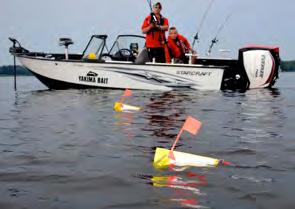
G&S Exclusive Tactics: Rob pulls Rapala crankbaits behind the smallest Offshore Tackle or Church TX-6 planer boards. We find these little 6” boards indispensable in exploring the hangout of giant, lethargic walleye lounging in “no man’s land”. The “near-edge” is the often-ignored, limited open water immediately out from the top edge of a drop off – out over the
•Where to find? – www.basspro.com – www.cabelas.ca
(Continued on page 51.)
7811 Hwy. 15 (Just south of Carleton Place) (613) 253-FISH (3474)

7811 Hwy. 15 (Just south of Carleton Place) (613) 253-FISH (3474) WE CARRY THE FOLLOWING UNIQUE BRANDS:



Just Fishing . 50

July 1 – 9 2023

Simply put, Doug Stange and James Lindner believe in mopping up the easy fish with hot colours such as chartreuses, hot pinks, fluorescent oranges and high-contrast colours. I absolutely follow their lead, especially when covering water to find schooling fish. However, I believe in further mopping up every fish in the school by executing a 1-2 Punch with both the hot colours, first, and then naturalistic patterns and colours once fish are located.
My experience has been that once fish are located, a natural coloured lure, or darker coloured lure will trigger more fish and, perhaps, larger, more experienced walleyes. Pro-Cure Super Gel adds Scent and Taste when a fish noses up in behind a swimbait before finally overtaking the lure.

To most people, the lines and tackle that we use for swimbait duty would be considered more for pike than for walleye. Well, when you are catching huge walleye that eat baby pike for breakfast, there is a very good reason why you need balanced tackle for swimbaiting.

My 13FISHING spinning combo is a the “Greenstick” FATE Radio Active Pickle (RPS71MH2) paired with the Source F 3.0 reel (SORF-52-3.0-CP) spooled up with #20, hi-vis Neon Lime coloured SUFIX ProMix Braid. Any high-vis colours will allow you to “line watch” since many strikes occcur when the lure is falling or when it
hits bottom. A 4-foot section of SUFIX Advance #20-30 Fluorocarbon Leader material provides the bite-off insurance needed in the North Country. The connection we use for the braid-to-fluorocarbon knot is the Back-to-Back Uni-knot. A Rapala loop knot is my preferred connection to the jig.
The simple advice for the hook set is Do Not do a violent strike and then pump the fish towards the boat. These two actions will guarantee a lost fish and ruin your confidence.
Note: I fish a very stiff drag and backreel once the fish is well hooked. It takes a bit of practice; but, with this method, I hook more fish and play-out a fish much faster than if I relied on a “perfectly set drag”.
Here’s how: When you get a hit, reel down to the fish and get into good body positon to sweep set the hook. Your hookset must load the entire rod. As you sweep the rod, reel quickly and smoothly applying stout, steady pressure.
DO NOT pump the fish; but, maintain the steady pressure and reel constantly until the fish gets to within about 20 feet of the boat. By now, the fish will have found its head and makes a powerful run. By this time, the lure will have slid past the teeth and the heavy 5/0 to 7/0 hook will securely find flesh.
As mentioned earlier, we always use Pro-Cure Super Gel in Anise or Walleye Formula. Yes, to create scent and taste that the fish will not reject. But, perhaps more importantly, the gel will give the substantial swimbait body a super-slippery surface that the fish’s teeth will not hold as easily. Thus, the slippery body slides through the teeth and the hook finds the corner of the mouth.
All these lures can be seen, in action, at getfishing.ca on our YouTube channel. The live, underwater strikes on the Storm 360GT, alone, are worth the price of admission!
Foot Notes: *ElaZtech is a Stretch-Armstrong-like, super-stretchy material that completely recovers after being completely crushed, chomped and stretched. It is highly buoyant so, the tail of the HerculeZ, for example, floats up and causes the jig to stand on its nose which makes it extremely snag resistant. ElaZtech melts regular plastic... follow instructions... store separately!
**Storm also offers a 1/2 oz. 360GT head for separate purchase. Excellent addition to the 3/8 head
***Plastisol lure bodies require some repair at the end of a fishing trip or before the body is completely destroyed by toothy fish. The best product on the market for this duty is Mend-It softbait glue.
About the Author: Jeff Matitdy
A Fishing Industry Professional for nearly 30 years as a Fishing Guide & Promotional Staffer, with Bachelor’s Degrees in both Science & Education, Jeff uses this training in his job as a Fisheries Professional & Outdoor Educator (specializing in fishing via family business, GetFishing.ca) to reach out to anyone interested in learning about fish.





TThe Detroit River runs south between Lake St. Clair and Lake Erie and is an extremely popular walleye fishing destination for both Canadian and US anglers. The Detroit River has both resident and migratory walleye spreading its lengths. Walleye can be caught throughout the year however, the most popular walleye fishing time occurs between April and May. This time frame corresponds with pre-spawn, spawning and post-spawning periods. To catch walleye, anglers commonly jig plastic baits vertically from boats as well as casting and retrieving plastic baits from shore. Both techniques often result in great catches!
Over the years, anglers have used two primary bait styles – the 4” fluke (Figure 1.) and 4” worm-style bait (Figure 2.). These plastic baits are rigged with a 3/4oz, 5/8oz, or 1oz jig head and come in a wide variety of colours. While there are other techniques used on the river such as trolling body baits or hand-lining plugs, jigging with fluke or wormstyle baits has been the most popular choice for anglers over the years. However, with recent changes in Great Lakes ecology, a new food source is dominating fish feeding preferences.

What other naturally occurring, abundant food sources could entice fish to bite?

The majority of Detroit River walleye live most of their lives in one of three places – Lake Erie, Lake St. Clair or in the Detroit River itself. All three water bodies vary in terms of food sources, depth, water temperature, clarity, water velocity and structure however they all have healthy populations of round goby. Since walleye enter the Detroit from multiple locations during peak fishing periods, it is important that anglers understand walleye feeding preferences and prepare their bait selection accordingly.
Lake Erie is the shallowest of Great Lakes and has a relatively low velocity, flowing from the west to east, draining into Lake Ontario down the Niagara River. Lake Erie walleye common food sources include yellow perch, freshwater drum, smelt, emerald shiner, invertebrates and round goby.
In the 1970’s and early 80’s, when zebra mussels were not yet introduced, walleye were heavily focused on ambush feeding in a traditionally pelagic (open water) food web. During this time, trolling crankbaits resulted in much success as walleye were accustomed to hunting
schools of smelt and other minnow-like fish. In 1988, with the accidental introduction of zebra mussels, Lake Erie was quickly transformed into a clear waterbody. Zebra mussels aggressively filtered zooplankton which was an important food source for mid-column prey such as smelt. This affected walleye two-fold. First, the overall reduction in smelt populations meant less food in the mid-water column for walleye to consume. Secondly, clear water conditions made it more difficult for walleye to ambush feed. This resulted in drastic reductions in walleye populations until the inadvertent introduction of the round goby. Round goby (goby), introduced into Lake Erie in the 1990’s brought new opportunity for walleye and transformed traditional open water feeding behaviour to a partially benthic (bottom feeding) food web.
Why? First, goby do not have swim bladders, forcing them to scoot and hop along the bottom. Their inability to evade capture, coupled with their bottom dwelling nature, makes them an easy meal for juvenile walleye. Secondly, with a reduction in overall mid-water column food sources, coupled with the sheer explosion of goby populations, many species of fish including walleye, bass, freshwater drum and yellow perch added goby to their forage base. In the past, when smelt and shiners were abundant, walleye had the tendency to prefer minnow style baits. Now with the decline in those bait fish and an overall increase in goby populations, walleye more than ever are tuning into goby. This makes artificial goby baits an obvious choice for anglers fishing the Detroit River, St. Clair River, Thames River, Menominee River, Maumee River, Saginaw River and surrounding Great Lakes.
Lake St. Clair is a much shallower and warmer water body than Lake Erie, with a heavy presence of aquatic vegetation particularly during the summer months. This relatively low flow lake runs from the north and drains into the Detroit River in the south where the average flow rate increases to 1.5 knots and can go as high as 9.5 knots. In Lake St Clair, walleye tend to focus more heavily on yellow perch, freshwater drum, shiners, round goby and invertebrates. It is interesting to note that biologists first recorded the presence of goby in the St Clair River, and still today it remains infested with them
Since then, goby continue to expand their footprint, which has driven bait companies like the Grumpy Bait Company to design and manufacture

realistic, soft plastic goby baits that “match-the-goby-hatch” across various waterbodies in the Great Lakes Region. See Figures 4,5,6.

The Detroit River ranges between 18ft to 52ft and is considered a highvelocity waterbody. Unlike Lake Erie and Lake St Clair, fish living or entering the Detroit River must acclimate to much different conditions that are driven by flow rates, water temperatures, water clarity and a fish’s ability to quickly identify potential food sources. The Detroit River has a smorgasbord of forage including minnows, goby and invertebrates.
Juvenile walleye that hatched in the Detroit River focus on consuming easy prey such as small minnows, small goby and invertebrates. They remain close to the bottom to conserve energy, find food and hide from predators. As they migrate to either Lake Erie or Lake St. Clair, juvenile walleye quickly learn how to identify food sources in high velocity aquatic environments. Something that they will remember when the reenter the Detroit as adults later in life. Among the easiest to identify is round goby. Their bulky body shape and habitual proximity to the lake/
river bottom make it easy for walleye to consume compared to minnow style baits that are slender and more agile.
During pre-spawn, when the water temperature hits ~40F, walleye migrate into the river and start aggressively feeding. Anglers can take advantage of the hot action using a number of fishing techniques and bait styles. However during the spawn, things can slow down as fish refocused on reproduction – traditional baits can become less effective. During this lull, walleye are tight to the bottom, conserving most of their energy on reproduction. This is when anglers can take advantage of the natural tendency for walleye to attack and consume goby – a behaviour that has been imprinted into a walleye from a young age.


Detroit River walleye are truly amazing top predatory fish. Not only must they make split decisions as food races down the river, they must also contend with dirty water conditions, making it even more difficult to feed. Imagine a plate of food being placed in front of you and before you can taste the food, the plate is taken away. You can smell it – you can see it – but you can’t eat it because it’s gone. That is the life of a walleye feeding in fast flowing rivers. In a split second, walleye need to identify if the food source is edible or not. In the context above, this means walleye need to make an “eat – or – don’t eat” decision before the food even gets to the table. That is an anglers challenge – to determine the best bait style that aligns to conditions and walleye feeding behaviour. For the Detroit, there are a number of factors including water clarity, water temperature, wind speed and direction, cloud cover and bait profile. For this section, we will focus on bait profile.
“Referring back to various walleye food sources, goby offer a great choice particularly in high flow environments. Why?”


First, round goby have elongated bodies with large heads, bulging eyes, two dorsal fins and a large vertically-aligned caudal fin. These visual characteristics have been imprinted in walleye throughout their lives, helping them to quickly identify goby profiles as a recognizable and easy-to-catch food source. They are a big target relative to other slim baits like worm of fluke (see Figures 7). In fact, Grumpy Bait Company’s Goliath Goby offers a 40% increase in overall cross-sectional, volumetric profile, compared to worm or fluke style baits. While some large, unrecognizable baits will spook walleye, goby are imprinted into their behaviour making the decision to bite in a split second a natural response. In addition, since walleye hug the bottom in fast moving waters to conserve energy, it naturally brings walleye closer to where goby are found – on the bottom. Not only is the shape and size of goby quickly identifiable, both goby and walleye naturally occupy the same space, making goby an easy and ideal bait choice.
In clear water conditions, fish can quickly distinguish prey at distance and chose to eat or not. Often, clear water conditions cause fish to become more spooked and selective in what they eat. In these conditions, experienced Detroit River anglers quickly adjust to clear


water conditions by changing their bait selection to more natural colours including blue/silvers, whites, browns and blacks. Grumpy Bait Company now offers a wide selection of natural coloured goby baits to help in these precise conditions, giving anglers highly realistic bait choices for finicky walleye.
In dirty water conditions, dark baits tend to catch more walleye. The primary reasoning for this is that dark baits offer a shadow-like appearance in the water that is more noticeable than bright colours. Turbid water is full of particulate matter that prevents sunlight from hitting and reflecting off baits causing a dulling effect that not only hides colours but prevents fish from determining bait profile. Profile in dirty water is very important and there is no more recognizable profile than that of a round goby. Their natural elongated bodies, bulging heads and larger vertical caudal fin make them easy-to-recognize even in dirty water. Making artificial, anatomically-correct goby baits even more important in dirty water conditions.
Now, there is also another water colour known as “slaughter-water”. This water condition runs somewhere between clear and dirty water and offers the most ideal fishing conditions to catch even more walleye. Slaughter water conditions are ideally suited for hot coloured baits that offer high visual contrast such as chartreuse/purple, limetreuse/black, hot orange/brown, black/silver etc. While mostly all bait colours will produced in these conditions, slaughter water is often hard to find. Most weekend warriors are at the mercy of whatever conditions they face on the weekends and is why having a variety of all colours



Key Concepts: Clear water = larger strike zone, Fish have more time to consider biting a bait or not, Natural or bright colours are more noticeable, More freedom to jig with larger strokes as strike zone is much bigger, Scent and scent trails can still help to entice the bite.
Key Concepts: Dirty water = small strike zone, Fish have less time to consider biting a bait or not, Silhouettes are more noticeable –darker is better, Keep jigging to a minimal height to keep bait in the strike zone, Scent, UV and GLOW all help to improve visibility.
When it comes to our well-being, some things will always be essential.

Fishing large flowing rivers like the Detroit or St. Clair can offer some interesting challenges. First, presenting your bait close to the bottom can mean the difference between catching limits, or coming home skunked. Most anglers know that if you are jigging from a boat, it is critical that your line be directly below the boat. The ideal situation is your line is exactly 90 degrees from the surface.
The question many new anglers ask is, “ Why is it so important to have your jig straight down?”
Most successful anglers will tell you that keeping your line straight down, jigging your bait directly on the bottom, allows for better jigging control, bite sensitivity, and hook setting ability. This is no easy task! Boat control requires constant adjustments to the trolling motor. Wind gusts, changes in river currents, avoiding other boats during the drift and contending with boat-wake can be a challenge. However, without good boat control, your odds of getting hookups will be drastically deduced.
TIP: Try to “follow” your line by pointing your trolling motor to where your line enters the water surface. Make sure to maintain a constant distance from the nose of the boat to your line through continuous micro adjustments to the speed and direction of your trolling motor. Anglers commonly call this “chasing line” and can really help you present your baits vertically.
It is also helpful to use high-visibility braid to help you see the line contrasting the water surface. Watch out for other boats and buoys!
Jigging turbulent, high-velocity rivers can offer some major challenges. Often, these water conditions make it more difficult for anglers to keep constant contact with the bottom where walleye are found. Anglers using plastic baits need to identify the right jig weight coupled with the right bait profile. Bulky plastics with protruding appendages can cause baits to move unnaturally and uncontrollably in the water column, away from strike zone. During tournaments, every second your bait is out of the strike zone can mean the difference between winning or losing.
While there are many styles of baits available for walleye anglers, some baits just make more sense when vertically jigging. Particularly with the invasion of round goby in the Great Lakes Region. Now, more than ever before, anglers are realizing that goby are an important food source for many fish species and are turning to goby-style baits. While Detroit and St. Clair river anglers have only had access to worm and fluke style baits over the years, Grumpy Bait Company is now leading the way and providing anglers with innovative, realistic goby bait choices:
Goby profiles are highly recognizable to walleye in high-velocity river environments, Round goby have become an important food source for Great Lakes walleye, Goby baits with two dorsal fins and one large vertically-oriented caudal fin are important features that trick walleye into biting, Goby baits in natural/realistic colours can improve catch ratio in clean water conditions, Goby baits in dark colours can improve catch ratio in dirty water conditions, Grumpy Bait Company specializes in goby baits and produces more styles and colours than any manufacturer in North America.
Questions about this article or want to learn more about Grumpy Bait Company? Please visit www.grumpybaits.com or email info@grumpybaits.com


Is Ontario the blue walleye capital of the world?
Seems like every single time
I see a blue-ish walleye it’s from somewhere in ON. Just came across another one posted by The Ontario Experience of a Smurfette caught outta Ghost River Lodges:
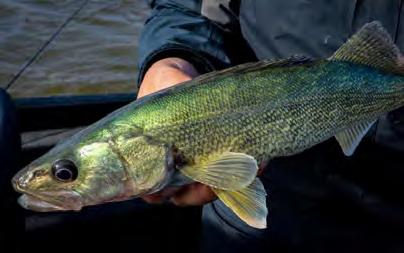

Love me some unique critters!
“Blue pike” were officially declared extinct in 1976 by the U.S. Fish and Wildlife Service. So what are the blue-ish variations of walleyes floating around the interwebz like the one above...? They are actually a different species than their extinct cousins. A little info below from John Hageman’s Sandusky Register write-up:
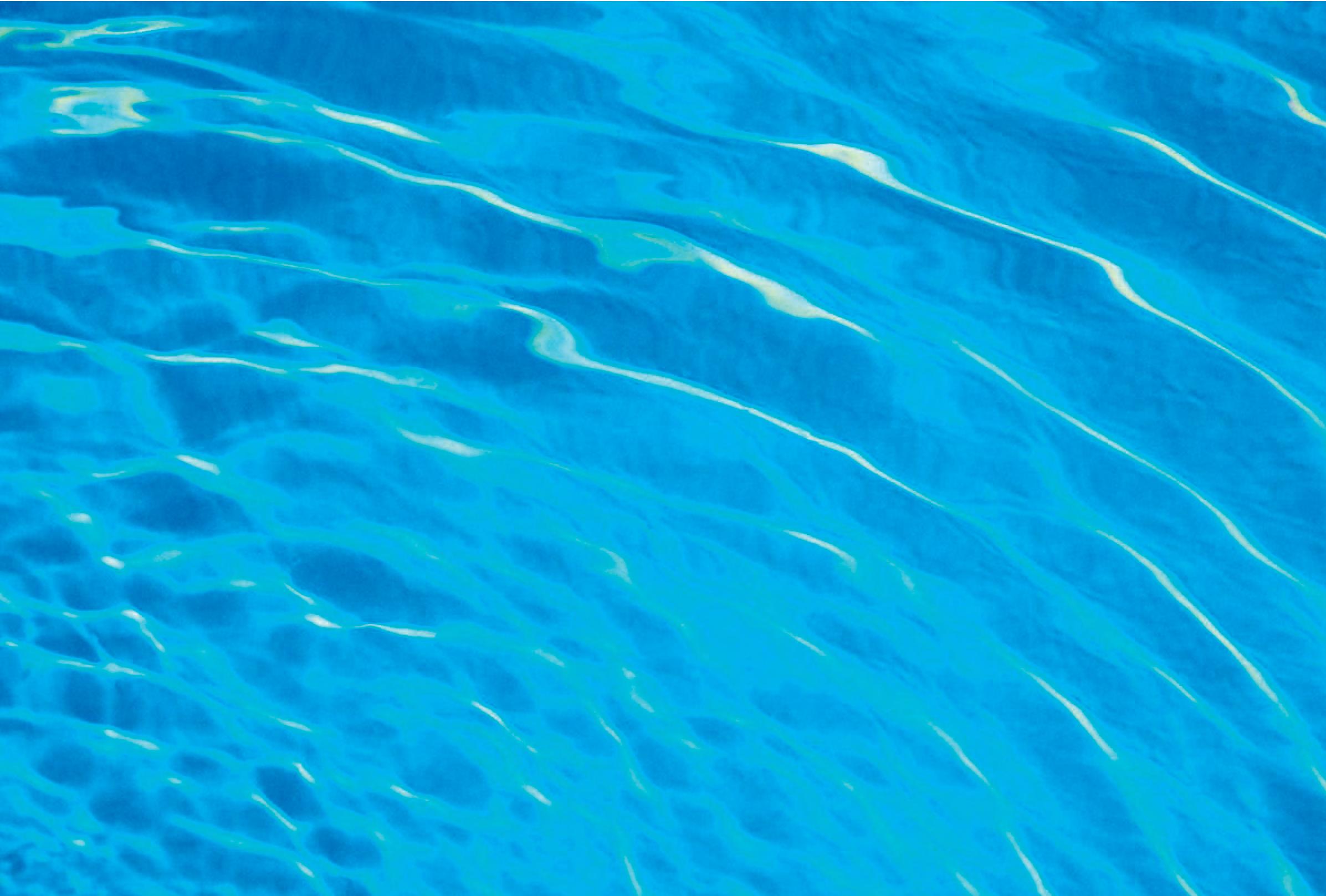
“In a few lakes in ON and QC, blue-colored walleyes are frequently caught, but DNA analysis has repeatedly shown that they are simply a blue colour-phased walleye that is missing yellow pigment and not a true blue pike.” Now you (we) know.
Oh, and if Ontario is the blue walleye capital of the world, then obviously Manitoba is the #greenback capital.


Just magical!

Btw their B-E-A-utiful greenish coloration comes from the limestonerich waters of the northern basin of Manitoba’s Lake Winnipeg.
Some say the greener the fish, the “fresher” they are to the south basin... or maybe it’s from all that MTN DEW they chug before making the trek? Lol! Eventually the green will fade/blend into a more white-ish look.
Either way they’re cool to look at and an absolute BLAST to catch.

Probably my favourite way to catch walleyes! They’ll eat a Ned rig all season long. But here’s a few keys to my program for spring walleye fishing on shallow sand, before the weeds grow up. Shot just a couple days ago in central MN:

I was catching ’em on a 3/16-oz VMC Ned Rig Jig (chartreuse) paired with a “green pumpkin goby” colour Z-Man Big TRD. There’s a zillion different Ned heads out there – few things that makes this one so fishy: A hybrid bend in the Ned Rig Jig’s 1X-strong, forged, fine-wire Vanadium Steel hook provides extra strength. A chemically sharpened needle point and a hybrid, wide gap ensures that bass (and of course walleyes!) stay buttoned...
Its traditional mushroom style head and 90° line-tie = drags smoothly on bottom, does a great job of hopping over rocks, and creates more lift for your plastics so they stand up. Comes in 4 sizes (1/16, 1/8, 3/16 and 1/4 oz) and 3 colours (black, green pumpkin and chartreuse). Love that all the sizes have a 1/0 hook, ‘cuz a lot of other jigs out there start bumping up the hook size the heavier they get... which is fine unless you’re trying to throw compact little baits like you typically want to with a Ned rig.
Btw I accidentally found out last summer (on an extremely tough bite) that the VMC Ned Rig Jig’s “beveled edge conical keeper” does an INCREDIBLE job of holding on a nightcrawler too. Honesty would have never guessed by looking at it! But the crawler would literally tear in half below the hook before the top would even slide down the keeper. Crazy cool.


You know it was an insanely tough bite if I stooped to throwing a half of a crawler versus plastics LOL.
Paid off that midsummer day tho.

“Tapenade” is a garnish that originated in Southern France and can be used in a multitude of applications. The salty olives along with the nutty almonds and floral lemon is an exceptional pairing with the trout.
The simplicity in this dish speaks for itself and can impress guests and family alike. If you desire a bit more sustenance in the dish, cook up some aromatic Jasmine rice, a perfect combination!
(Yield: 4 Servings)
INGREDIENTS:
TAPENADE:
4 x 5oz Trout fillets
2 Cloves Garlic, chopped
6 Black Olives, seeded, chopped
60ml Sundried Tomatoes, in oil, chopped
50ml Slivered Almonds, chopped
15 ml Parsley, chopped
30 ml Olive Oil
10 mil Lemon Juice
Kosher Salt & Pepper, pinch
DIRECTIONS:
Preheat oven to 350F0.
SALAD:
3 cups Assorted Field Greens
10 Heirloom Tomatoes, cut in half
60ml Olive Oil
30ml Balsamic Vinegar
5ml Dijon Mustard



5ml Liquid Honey
Kosher Salt & Pepper
Lemon Wedges, optional
Clean and fillet trout, remove pin ones with fish tweezers and cut into 5oz (150g) portions. If desired, the skin can be left on.
In a mixing bowl, combine the remaining ingredients for the tapenade and combine. Using a parchment lined baking sheet, place the trout skin side down then top with tapenade mixture. Bake for approximately 15-18 minutes.
While trout is cooking, combine the olive oil, balsamic vinegar, Dijon mustard, honey and seasoning, add salad greens, tomatoes and toss.
When trout is finished, plate together with salad, can serve with lemon wedges. Happy Cooking!

Editor’s Note: Avid outdoors person, competitive angler, 2-time gold medal winning chef at the Culinary World Olympics and educator Cameron Tait truly loves being in the outdoors. Cameron is an active member of the Manitoba Wildlife Federation, Walleye Anglers Assoc. of Manitoba, Central Walleye Trail and on the Pro Staff team for Alumacraft / Suzuki and Minn Kota / Humminbird. When not pursuing his passion for the outdoors, Certified Chef du Cuisine Cameron can be found surrounded by mouth watering food.





